First published October 2019 | Words and photos by Vietnam Coracle | 4 comments
This post was last updated 5 years ago. Please check the comments section for possible updates, or read more on my Updates & Accuracy page.
INTRODUCTION | GUIDE | MAP | RELATED POSTS
The Pirate Islands (Đảo Hải Tặc) lie in the Gulf of Thailand, just off Vietnam’s southwest coast, between Ha Tien and Phu Quoc. A small, rugged archipelago with calm seas and green hills, the Pirate Islands have only recently opened to foreign travellers. For centuries, the islands provided shelter for pirates, who lay in wait in the rocky coves, poised to attack commercial ships plying the lucrative Southeast Asia trade route, laden with goods. Today, the Pirate Islands have a wild and rustic charm: electricity is limited, accommodation is basic, the population is small, and the scenery is relatively unspoiled. But change is coming. Soon the Pirate Islands will be connected to the national grid, giving residents 24-hour electricity for the first time. And this is expected to spark a tourism boom. Below is my full travel guide to the Pirate Islands.

Pirates Islands (Đảo Hải Tặc): a small archipelago in the Gulf of Thailand, between Ha Tien & Phu Quoc
[Back Top]
GUIDE: PIRATE ISLANDS (ĐẢO HẢI TẶC)
Below is my full guide to the Pirate Islands (Đảo Hải Tặc), including a detailed map. I’ve divided this guide into several categories (see below), and then sub-sections within each category. The best time of year to visit Pirate Island is November to April, when the weather is generally dry and bright, rainfall is light, and seas are calm. Try to avoid weekends and public holidays, when visitor numbers increase. It’s possible to visit Pirate Island as a day trip from Ha Tien, by taking the morning ferry out and the afternoon one back. However, I would recommend spending at least two days and one night. The main island in the archipelago is known by several names, but for the purposes of this guide, I will refer to it interchangeably as both ‘Pirate Island’ and ‘Hai Tac Island’.
Click a category in the contents below for more details:
CONTENTS:
MAP:
Pirate Islands (Đảo Hải Tặc), Kien Giang Province
View in a LARGER MAP
Location & Background:
Below I’ve written a description of the location and topography of the Pirate Islands and a little bit of history and background, followed by some information about the current state of the natural environment:

Glassy seas on Pirate Island & nobody there to see it: but change will come
Orientation, Topography & History:
The Pirate Islands Archipelago (Quần Đảo Hải Tặc) comprises 16 islands. These islands make up Tiên Hải commune, part of Kiên Giang Province. However, only a few (perhaps six) of the islands are permanently inhabited. The Pirate Islands lie in the Gulf of Thailand, roughly 20km west of Ha Tien, on the mainland, and 40km east of Phu Quoc Island. Most of the archipelago’s population of a couple thousand live on the largest island, which is known variously (and confusingly) as Đảo Hải Tặc (Pirate Island), Tiên Hải (Sea Fairy Island), Hòn Tre Lớn (Big Bamboo Island), and Hòn Đốc. Whichever name you choose, this island is the administrative and commercial centre of the archipelago: it’s where all tourist infrastructure is located.


Pirate Islands (Đảo Hải Tặc) comprises 16 small, rugged islands off Vietnam’s southwest coast
Rugged and green, the Pirate Islands got their name for good reason. Their location, in the middle of an ancient, lucrative and busy trading route between China, Southeast Asia and the Indian Subcontinent, made the islands an ideal hideout for pirates. For several centuries, pirates used the islands as a base from which to launch raids and rob passing commercial ships as they sailed their cargo through the straits between Phu Quoc Island and the mainland. Apparently, the pirates painted a broom or mop on their sails, symbolizing the thorough job they did of ‘cleaning’ the ships of their cargoes. The pirates are said to have stashed their booty in the nooks and crannies of the rocky archipelago. Indeed, there are still rumours of buried treasure on the islands, and a haul of old coins has already been discovered. Pirating continued right up until 1975. Today there’s still something of a rough edge to the Pirate Islands, because of a large military presence due to its proximity to Cambodia, with whom Vietnam has a checkered history. When I arrived there was an assault and target practice underway on Bai Bac beach.
*Please note: Historical information in this article is based on my reading of various sources & conversations with people: I am not an historian.

The islands get their name from pirates who used the archipelago as a base from which to attack ships
The Pirate Islands are less developed and friendlier than Vietnam’s other islands in the Gulf of Thailand. Although not as striking as Hon Son, not as sophisticated as Phu Quoc, and not the same quality beaches and water as Nam Du, the Pirate Islands are much quieter, less trodden, more open, and more rustic. Approaching the archipelago from the mainland, the islands come into view like ships on the horizon: little, grey-black silhouettes floating on a silver sea. Until very recently, foreign visitors weren’t allowed to set foot on the islands; now they’re gearing up for tourism. The long, high ridges of Phu Quoc Island are always visible on the horizon to the west, as are the irregular bumps of Ha Tien’s limestone hills to the east. A bonus of this location, for me at least, is being right in the path of the Ha Tien↔Phu Quoc ferry route. This crossing has exploded in recent years, and you can watch the boats – car ferries, fast boats, cargo ships – ply back and forth from anywhere on the south, east and west coasts of Pirate Island. The archipelago is also very close to Cambodia. Indeed, my phone thought I was in the Khmer kingdom, sending me a message: ‘Welcome to Cambodia’.


Life on the Pirate Islands is slow & quiet, but that’s set to change with the advent of 24-hour electricity

Fishing is the main industry on Pirate Island, but tourism is expected to play a major role in its future
[Back]
Environment & Pollution:
The Pirate Islands are on the cusp of big change. This, of course, could be said of many places with tourist potential in Vietnam. But this archipelago is just about to be connected to the national grid, giving it 24-hour electricity for the first time. This, in turn, is set to fuel a tourism boom. I visited in October 2019, when everyone and everything was gearing up for the arrival of electricity and an expected explosion of visitors. The harbour was being redeveloped, stone quarried to construct new piers, bungalows on the beach being built, rudimentary English being taught to islanders in order to communicate with foreign travellers, and a large new reservoir to provide a constant supply of clean water. This means, as with anywhere in 21st century Vietnam, there’s ongoing construction on the islands. Compared to other places in the country, however, it’s very mild. But you still get cement trucks plying the narrow lanes, kicking up dust, the sound of drills and hammers, and the sprawl of building materials awaiting use. This is just a symptom of a nation in the midst of industrialization and, in this case, a pleasant island getting ready to make money from tourism. Fortunately, it’s not too disruptive on Pirate Island, yet. And, I suppose, one must remember that the concrete guest house one is staying in and the paved road to get there, was once a noisy, unsightly construction site.
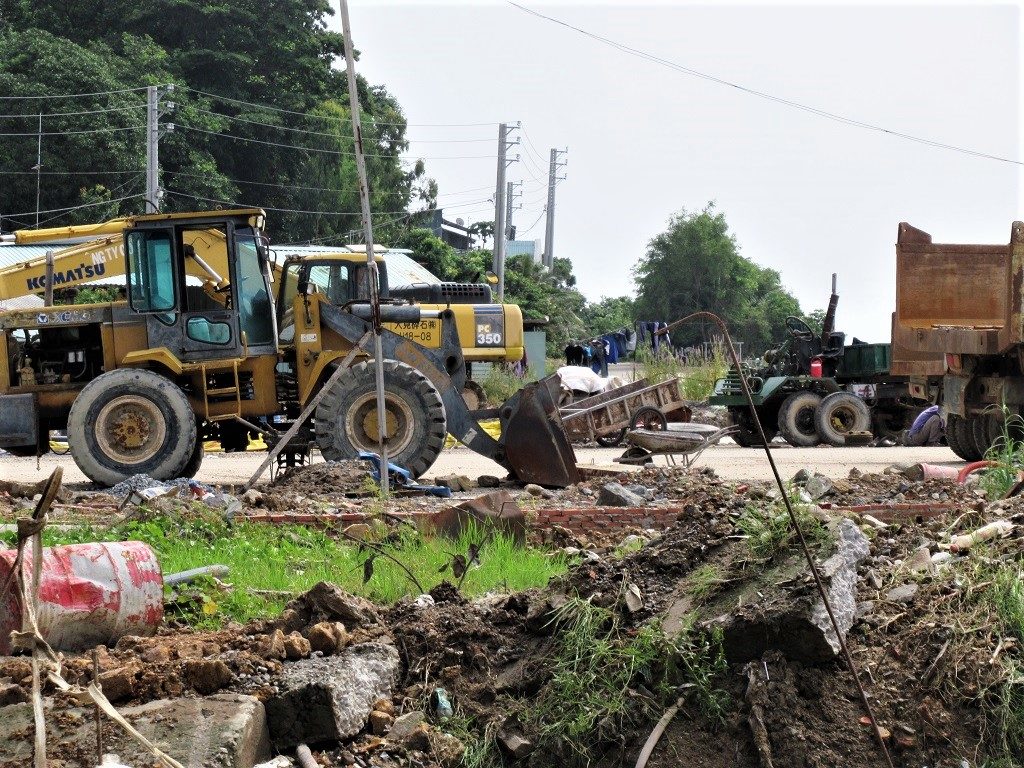
Construction work on Pirate Island is ongoing but relatively small-scale; that may change in the future
When I visited Pirate Island, electricity was still in limited supply: power cut out daily between 11pm and 5am, as well as regular outages during the day. The islands were noticeably quieter than other beach destinations in Vietnam, largely thanks to the absence of karaoke blaring into the night. (Hopefully, noise pollution will not become an issue once the islands are connected to the national grid.) Unsurprisingly, the islands have caught the eye of resort developers: two islands are already being developed by River Hotel, based in Ha Tien. And so, I imagine, development will continue to grow and things will continue to change, as they always do. But, whether it’s for the better or the worse, remains to be seen.

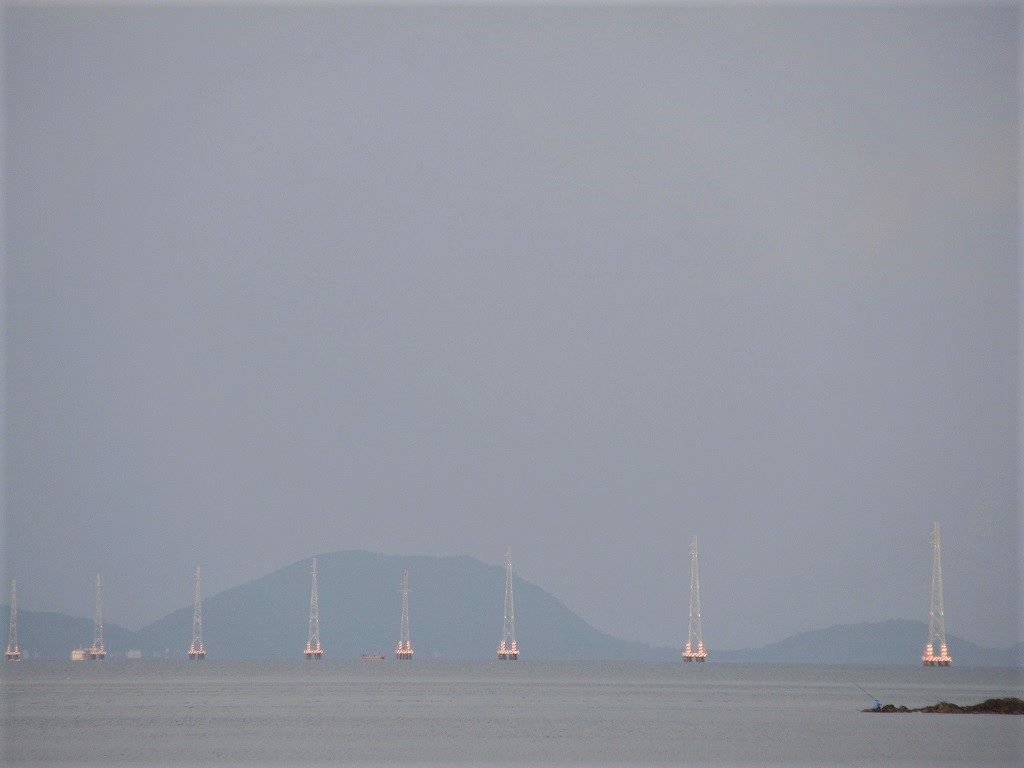
This line of electricity pylons at sea will bring 24-hour power to the Pirate Islands for the first time
Water quality is pretty good around the Pirate Islands. But it’s a sad fact that you’re never far from plastic trash in Vietnam’s seas these days. A lot of it is fishing detritus, discarded by fishermen and then washed up on the beaches; but a lot of it is household trash, discarded by the local community and visitors to the island. The situation on the Pirate Archipelago is nothing like as bad as other islands in Vietnam. However, it’s difficult to see how the problem of trash will be contained if the expected tourism boom is to happen. There’s a landfill – fairly empty at the moment, but it’ll fill up quickly, as it has done on other islands – and there’s evidence of plastic trash being collected, presumably to be sent back to the mainland for recycling. Government signs can be seen all over the island, encouraging proper disposal of trash and protecting the local environment. I hope that Pirate Island doesn’t follow the same path as other islands before it, where litter quickly built up in the harbours and on the beaches as the local population swelled, tourist numbers increased, and infrastructure projects were implemented. In my time on Pirate Island, I witnessed trash thrown in the sea on several occasions, as well as trash left on the rocks and on the sand. The results of this casual disposal of plastic waste is clearly visible on the ferry crossing from Ha Tien: hardly a moment goes past on the boat’s deck, looking out at sea, without a plastic bag, polystyrene box, plastic bottle, plastic sachet of shampoo, crisp packet, or beer can floating by. It wasn’t always this way.
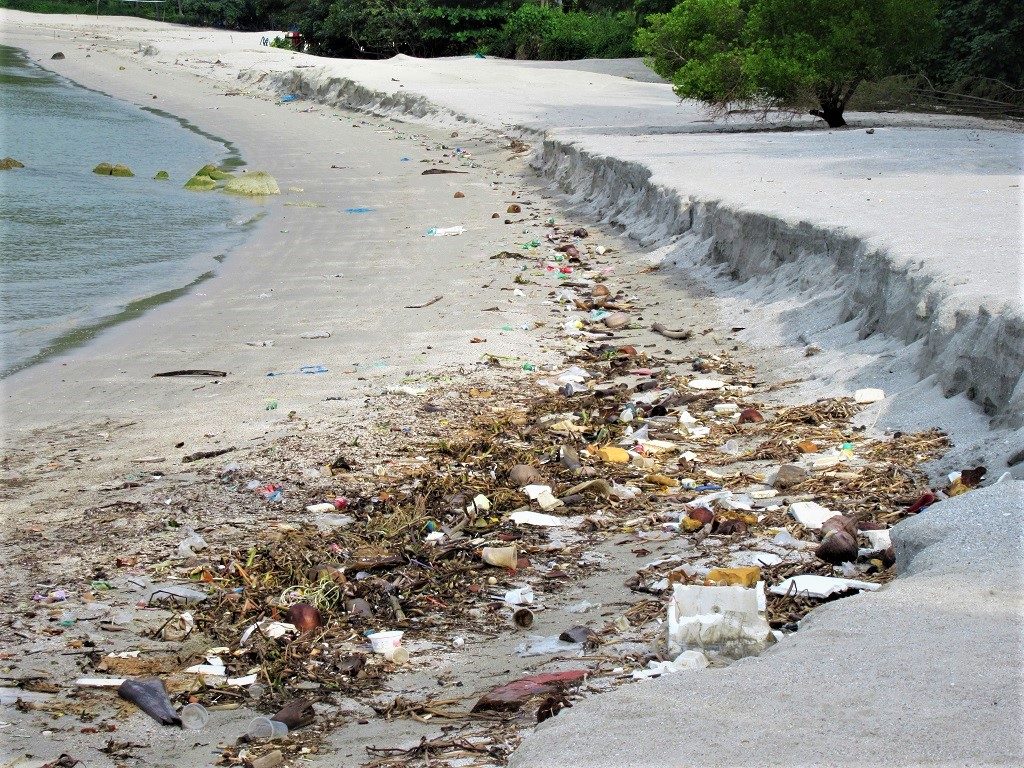
Trash washed up on Bai Bac beach: litter is a huge problem all along Vietnam’s long coastline
Things to See & Do:
As mentioned above, the Pirate Islands are on the cusp of big change, but for now this archipelago is quieter, less developed, more rustic, and friendlier than the other islands in Vietnam’s portion of the Gulf of Thailand. Although not as striking as Hon Son, not as sophisticated as Phu Quoc, and not the same quality beaches and ocean as Nam Du, the Pirate Islands are far less-trodden. There’s not much to ‘do’ as such. But, if you’re an independent traveller with similar tastes to mine, then exploring the islands on foot, two wheels and by boat, as well as swimming in the sea, and chatting, eating and drinking with local people, will be perfectly satisfying for a couple of days. (Once again: don’t travel on the weekends or public holidays):
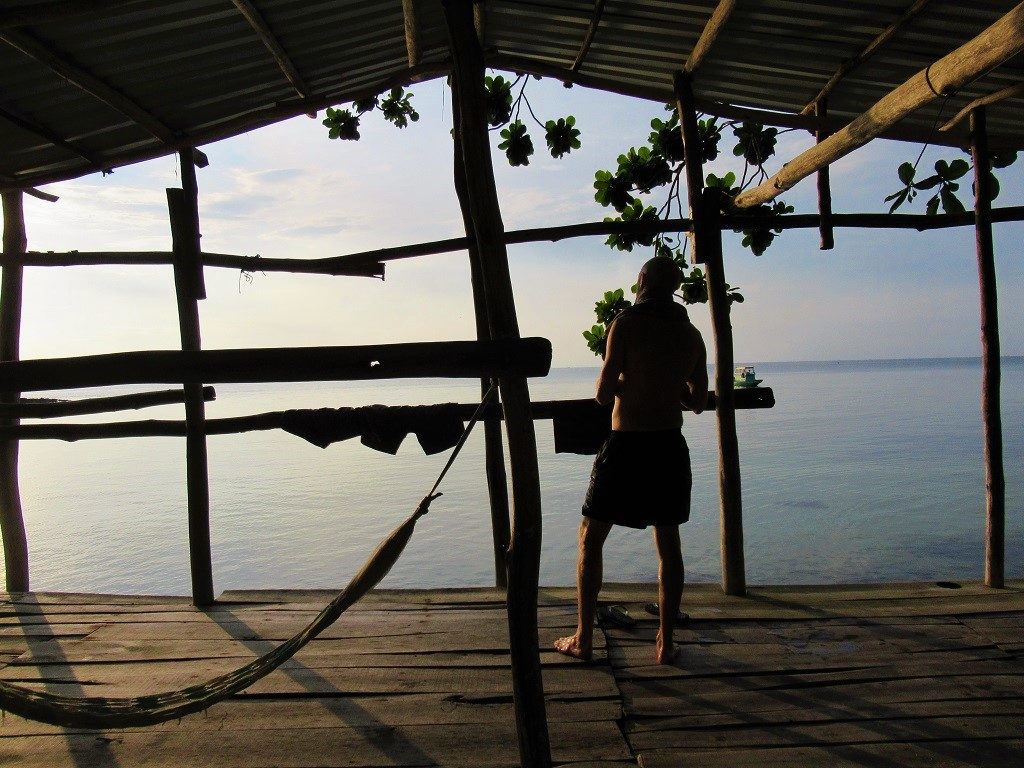
Things to do on Pirate Island: exploring on two wheels, swimming, fishing & swinging in hammocks
The main island is rugged, green and very attractive. Most of the coastline is rocky, but there are two sandy beaches that are very pretty and good for bathing. The first beach (and this is my favourtie spot on the island for swimming and relaxing), is a tiny smile of white sand beneath a fringe of squat coconut palms. In the far west of the island, the beach is very small and often has some clutter on it. But, just next to the beach, a raised wooden platform juts out over the water, strung will hammocks for laying in and gazing over the glassy ocean. This is the perfect place to relax, swim, read, write, play the guitar, sing, or do whatever it is you do when there’s nothing to do. Anytime of day is good, but 4-6pm is glorious. You can stay right by this beach at Minh Luan (see Accommodation for details).

My favourite place to swim & relax is this small, pretty beach in the far west of Pirate Island

There’s a perfect wooden ‘hammock platform’ on which to relax, watch the sun set & swim off
The second beach, Bãi Bắc, is the main attraction for most visitors to the island. Bai Bac is a long arc of white sand stretching along much of the northern coast. Backed by palms and with shallow, calm, turquoise water, Bai Bac is very picturesque. The Cambodian islands and mainland (around Kep) form a pleasant backdrop to this brochure-worthy tropical beach. But Bai Bac is getting a bit scruffy these days – some litter, flotsam and jetsam, discarded building materials, and minor construction – and water quality can be murky. It’s absolutely fine, but perhaps not quite as good as it looks from afar. There are a couple of seafood shacks, drinks stalls, and chairs and hammocks on the beach. If and when development of the island starts in earnest, Bai Bac is where it will be. There are a couple of places to stay on Bai Bac beach (see Accommodation for details).
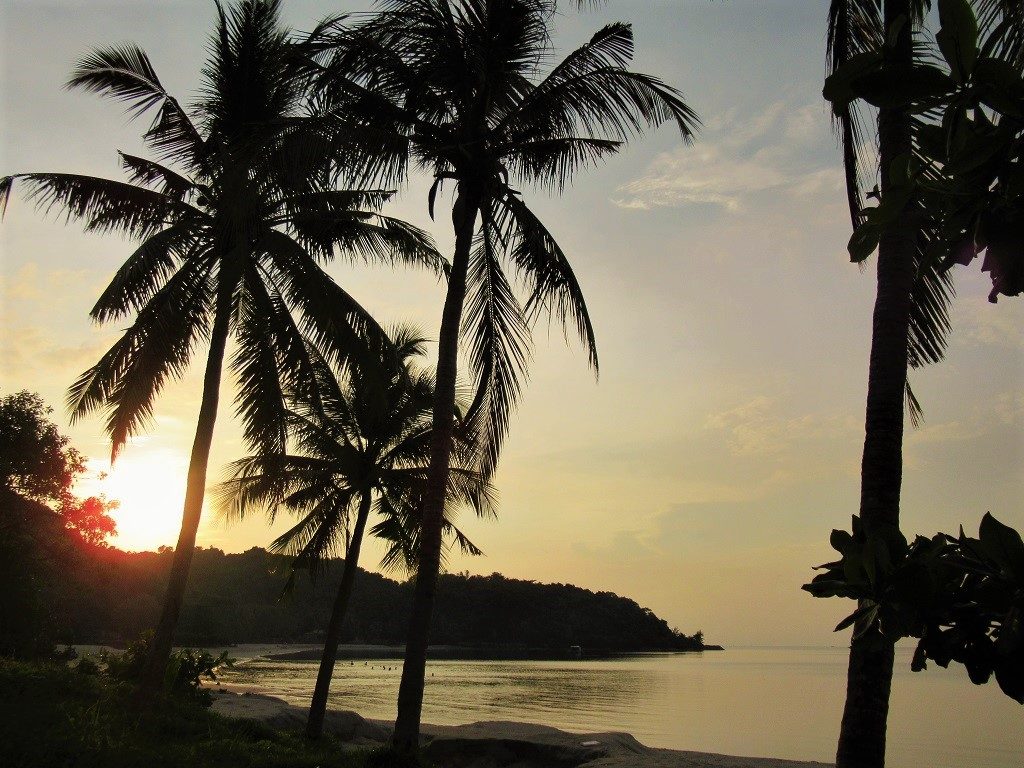
Bai Bac is an attractive white sand beach stretching along much of the north coast of Pirate Island
[Back]
Biking & Hiking:
Pirate Island has a limited, very manageable, and scenic road network. One paved lane rings the entire island, following the coast and making a pleasant 5km circuit: rideable in 15 minutes by motorbike, 30 minutes by bicycle, or 2-3 hours on foot. Obviously, factor in more time for stops to swim, swing in a hammock, munch on a snack, chat to some local people, and explore. The two inland roads are short, steep and lush: one runs south to north, connecting the ferry port with Bai Bac beach; the other forks west, past the island’s reservoir, before leading down to the coast. I had my motorbike, which was, as always, great fun. But, in my opinion, walking or cycling is a better option for Pirate Island. It’s one of the few places in Vietnam where life moves slowly and noise pollution is minimal, so travelling on foot is well-suited to the island. What’s more, when you’re on foot, you’re much more likely to meet local people, smell the perfumes of nature, here the wind in the leaves, the wash of the sea, the calls of birds, and just soak up the stillness and silence of the island. Bicycles and motorbikes can be rented from some of the accommodations on Pirate Island, such as Phuong Thao and Minh Nga, among others (see Getting Around and Accommodation for details).
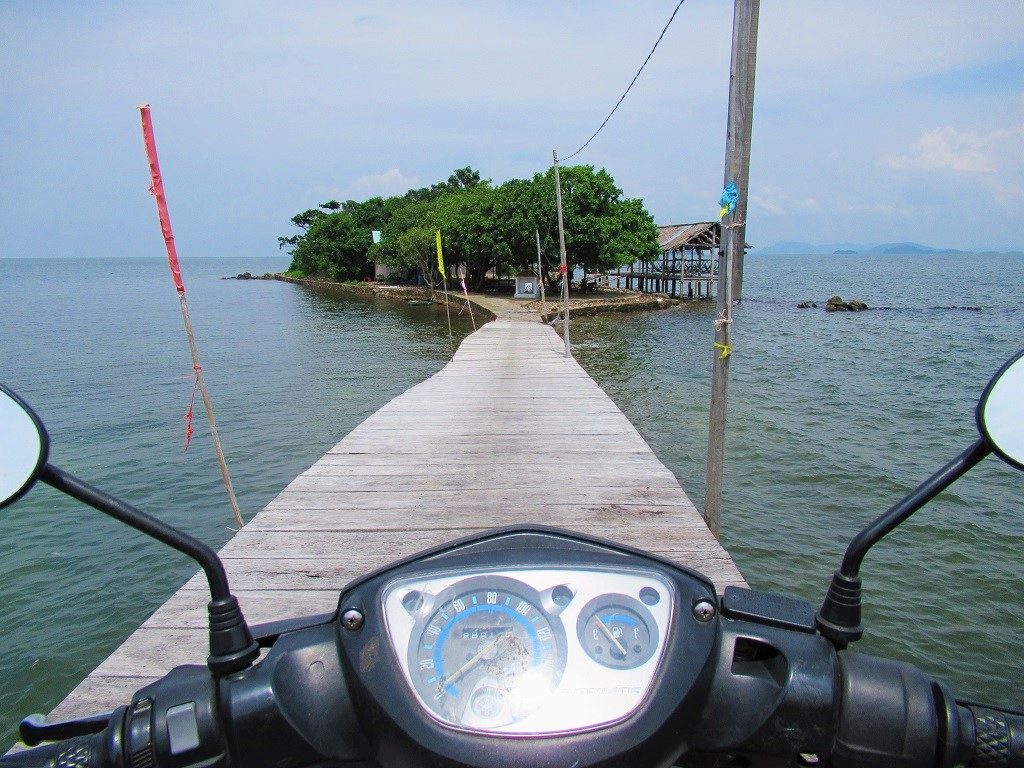
Biking around Pirate Island’s tiny network of pretty, paved lanes is good fun
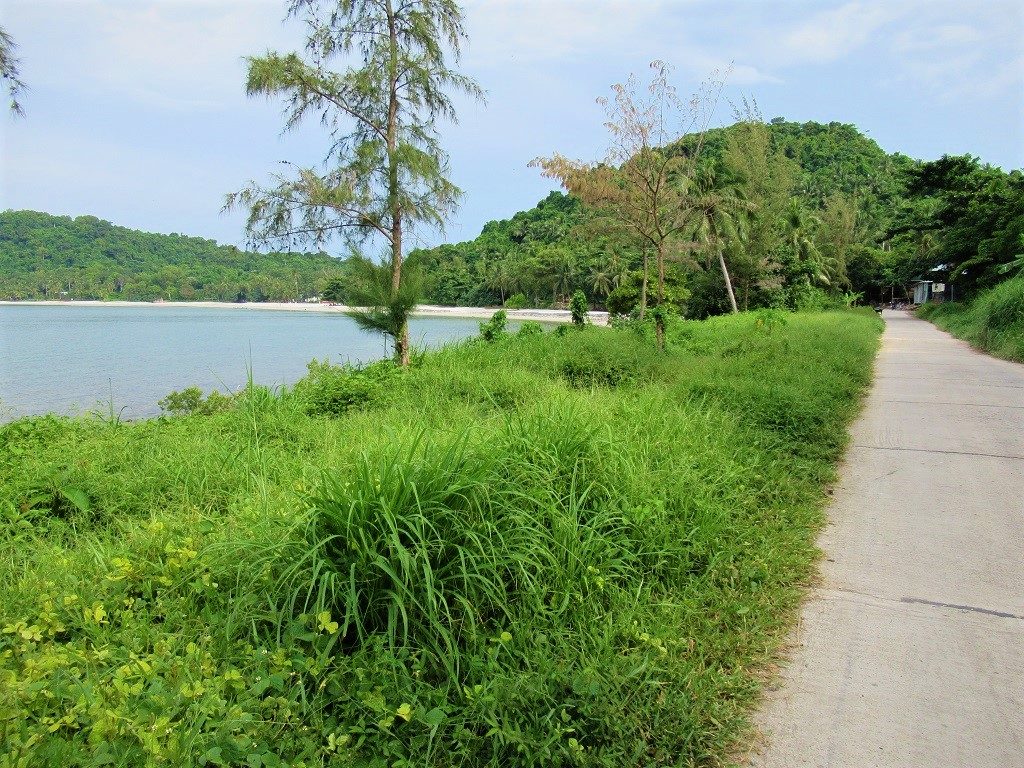
There’s no traffic on Pirate Island, making walking a very pleasant way to see the island
[Back]
Temples, Shrines & Memorials:
There are two local places of worship on Pirate Island, both on the hill behind Bai Bac beach. Miếu Bà Chúa Hòn is a small shrine dedicated to the island deity, accessed via a short, steep stairway, directly behind the stele commemorating the official ownership of the island, in 1958. Further along the coast road, a paved lane rises to Sơn Hòa Tự, a pleasant, leafy temple erected to honor a famous local pirate who is said to have sailed to Thailand, fell in love with a local woman, and brought her back to the islands, whereupon he gave up the pirate life. It’s a nice, cool, shady, contemplative place with sea views. The road continues up to a lighthouse, but is off limits due to military presence.
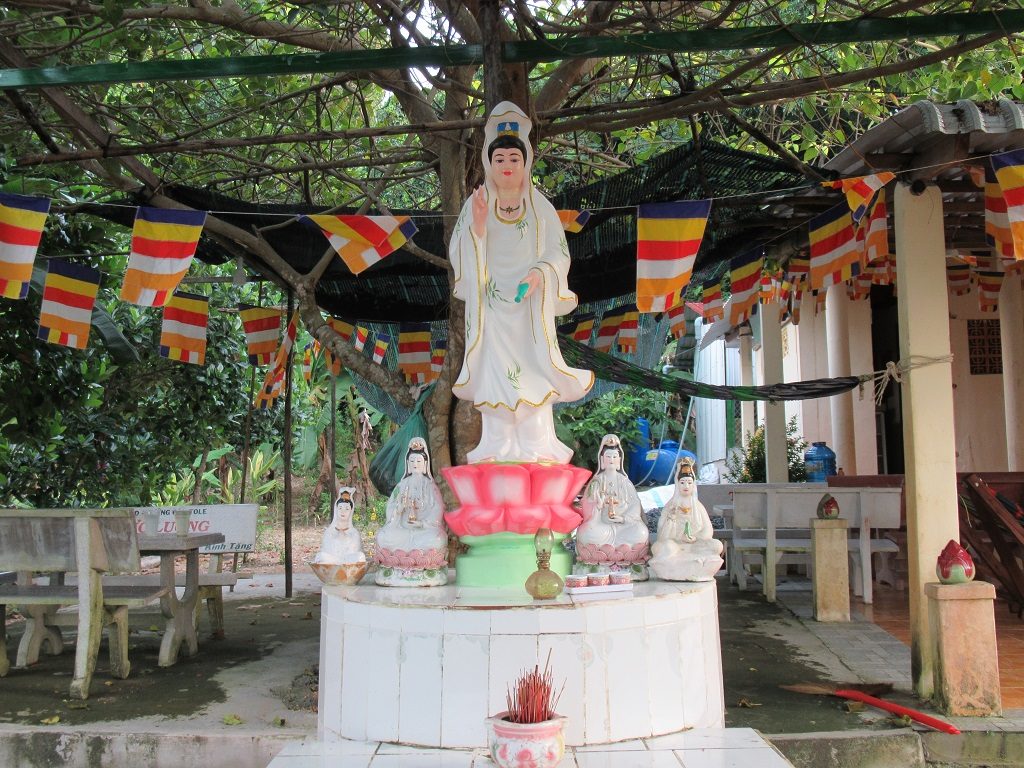
There are two temples on Pirate Island: one to the island deity, the other honoring a local legend
[Back]
Boat Trips & Fishing:
Boats to the outlying islands can be arranged quite easily, usually through your accommodation. A half-day costs between 400,000-600,000vnd and can include visits to hidden coves, beaches, fishing communities, snorkeling, and scavenging for crustaceans. You can also try night squid fishing. (See Getting Around for details).
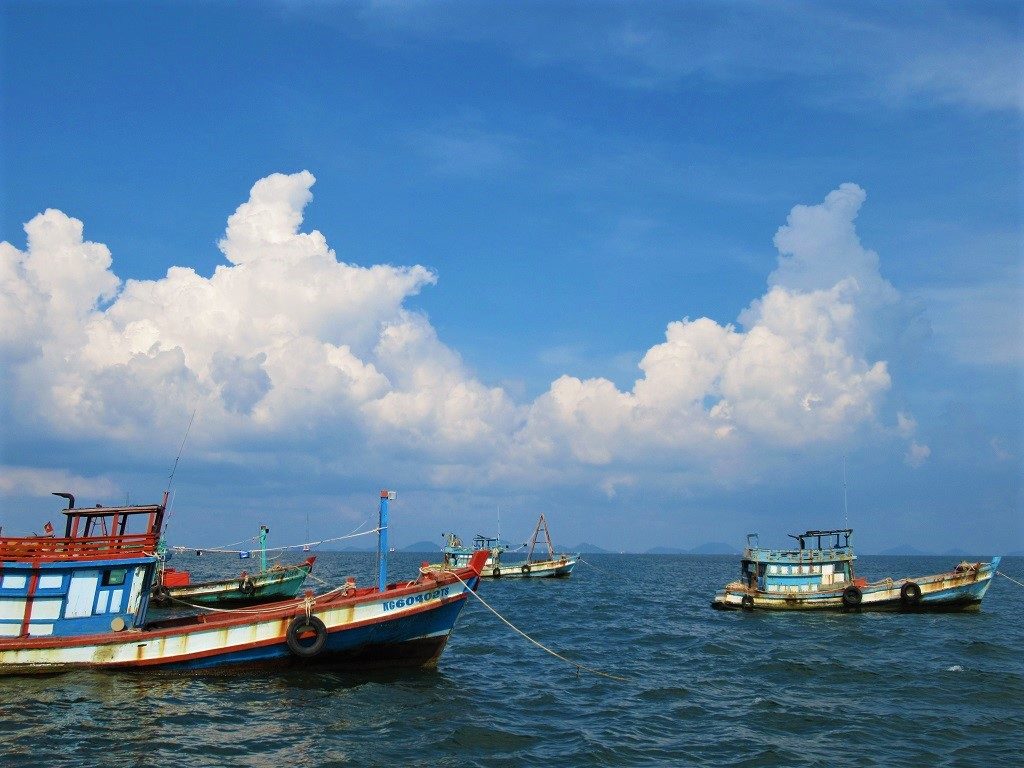
Boat trips to the outlying islands can be easily arranged; so too can night squid fishing trips
Accommodation:
*Please support Vietnam Coracle: If you use any of the relevant links below to book your accommodation, I make a small commission (at no extra cost to you). All my earnings go straight back into this website. Thank you.
As many travellers will need to spend a night in Ha Tien, on the mainland, before/after catching the ferry to/from Pirate Island, I have included accommodation information for both Ha Tien and Pirate Island below:
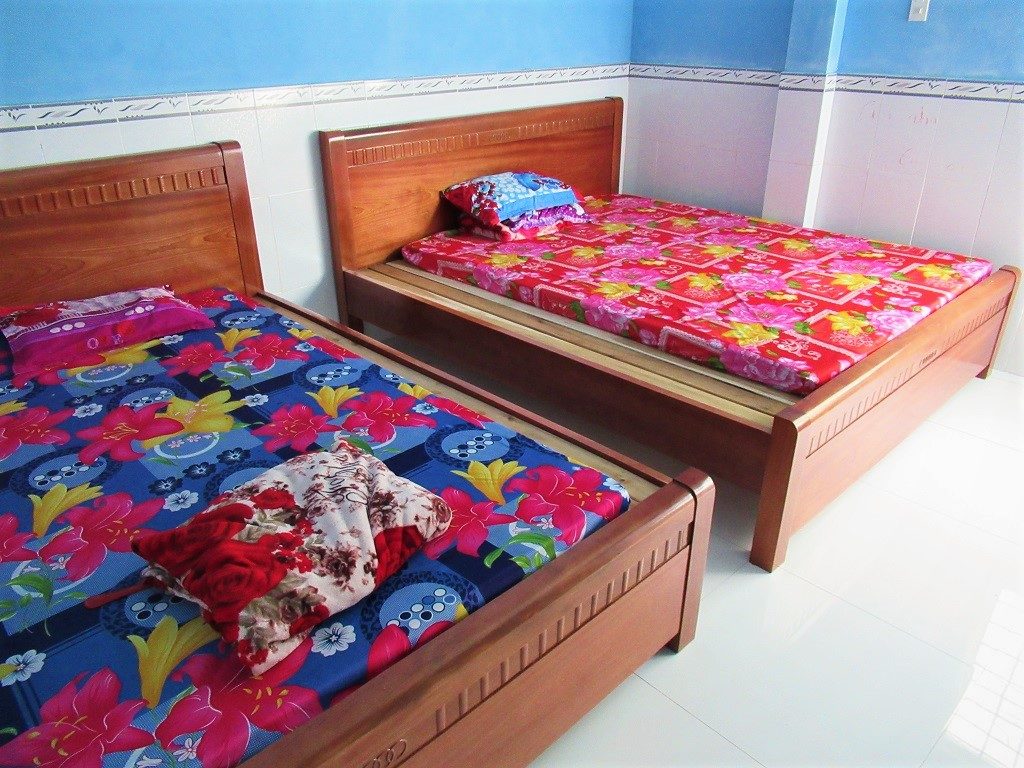
Accommodation on Pirate Island is basic but fine; on the mainland, Ha Tien has lots of good value hotels
Ha Tien Accommodation: Ha Tien is an extremely pleasant town on the banks of the Giang Thanh River as it flows into the Gulf of Thailand. There’s a good range of cheap hotels in Ha Tien where you can stay on the way to/from Pirate Island. Below are just a few options. (See my full Guide to Ha Tien for more details):
• Hai Yen Hotel [MAP]; 15 To Chau Street | tel: 077 3851 580 | 200,000-500,000vnd: Straddling the quiet corner of To Chau and Chi Lang streets, Hai Yen Hotel is in the east of Ha Tien, near the confluence of the Dong Ho Lake and the Giang Thanh River. A white-painted five-storey building, the hotel offers dozens of rooms, all of which have either balconies or windows. Particularly nice (and excellent value for money) are the corner rooms on the higher floors, which have views over the lake, river, town and surrounding hills. All rooms are bright, spacious, clean and comfortable. Rooms for 1-4 people are between 200,000-500,000vnd.

Hai Yen Hotel is a very good mini-hotel & one of the best value places to stay in Ha Tien
• Hai Phuong Hotel [MAP]; $10-$20 [BOOK HERE] Between Ha Tien’s main street and the waterfront, Hai Phuong Hotel has long been the town’s go-to backpacker accommodation. And for good reason: rooms (of which there are plenty) are cheap, bright, comfortable, clean, and quiet. If you’re a solo traveller, there’s a good chance of meeting others here to share your travel stories with and perhaps continue on to Pirate Island together. Most rooms have balconies with river views. It’s well-situated for access to the riverfront promenade, markets, and food outlets on Tran Hau Street. Rooms range from $10-$20 [BOOK HERE]
• Long Chau Hotel [MAP]; $1o-$20 [BOOK HERE] One of the best of a large block of budget hotels, Long Chau boasts a waterfront location that’s perfect for people watching and observing the river traffic as it comes and goes throughout the day. Long Chau offers nicely presented, very clean rooms. Try to get a room with a balcony as they have excellent views of the Giang Thanh River flowing out to sea and the To Chau hills to the east. Average prices are $10-$20. [BOOK HERE]
• River Hotel [MAP]; $30-$50 [BOOK HERE] A multi-storey structure of curving glass right on the riverfront, it’s difficult to miss River Hotel, currently Ha Tien’s plushest accommodation. On weekends and public holidays it’s popular with large tour groups, but during the week it can be almost empty. Rooms are spacious, clean, tastefully furnished, and receive lots of natural light thanks to the large windows. The views over the river, hills, and town are fabulous (although there are no balconies). Average rates are from $30-$50 [BOOK HERE]

Ha Tien has lots of good budget hotels to choose from, like Hai Phuong Hotel (pictured)
[Back]
Pirate Island Accommodation: All accommodation on Pirate Island is in the budget price bracket. At the time of writing, accommodation is pretty basic, but in decent supply. There are essentially two kinds of accommodation on Pirate Island: private rooms in bare but clean guest houses (called phòng trọ or nhà nghỉ), or hammocks on open-air platforms under a roof. As a general rule, the former runs from 150,000-400,000vnd (1-6 persons), and the latter from 40,000-80,000vnd. Guest house rooms are basic: a firm mattress on the floor in a clean, featureless, fan-cooled room. Some have a private toilet and shower, others are shared. Power generally cuts out from 11pm-5am, during which time you can use the battery-powered floor fan instead. However, by the time you read this guide, Pirate Island should already have 24-hour electricity, and then, I suppose, many guest houses will provide air-con. Hammocks are a cheap and romantic option: usually strung up in groups by the ocean. However, although these are perfect for a daytime nap, over night there’s no protection from bugs. Camping is also a possibility: if you bring your own tent, you can pay a small fee to set up where the hammocks are. Wild camping might be OK too, but would draw attention (not such a good idea on an island with a military presence). Try to avoid weekends, when places can be full up. As with everything else on the island, the range and type of accommodation will probably change/expand very soon, as a result of being hooked up to the national grid. Below are several options:
• Phuong Thao Homestay [MAP]; Tel: 0919 047 659 | 0944 822 224: On the south coast of the island (easy walking distance from the ferry pier), Phuong Thao is a friendly, basic but clean, fairly large guest house. Bare rooms feature mattresses on the floor, fans, air-con (when the power is on), and private toilets with showers. The property fronts the ocean, where there are hammocks. It’s a rocky beach and too close to the port and settlement to be any good for bathing. Boats to outlying islands and fishing trips can be arranged.
• Minh Nga Guest House [MAP]; Tel: 0947 942 414 | 01252 602 135: Next door to Phuong Thao, Minh Nga has similar rooms and amenities. Some rooms are large enough to accommodate 4-6 guests, making it good value for money for small, budget groups. Boats to outlying islands and fishing trips can be arranged.
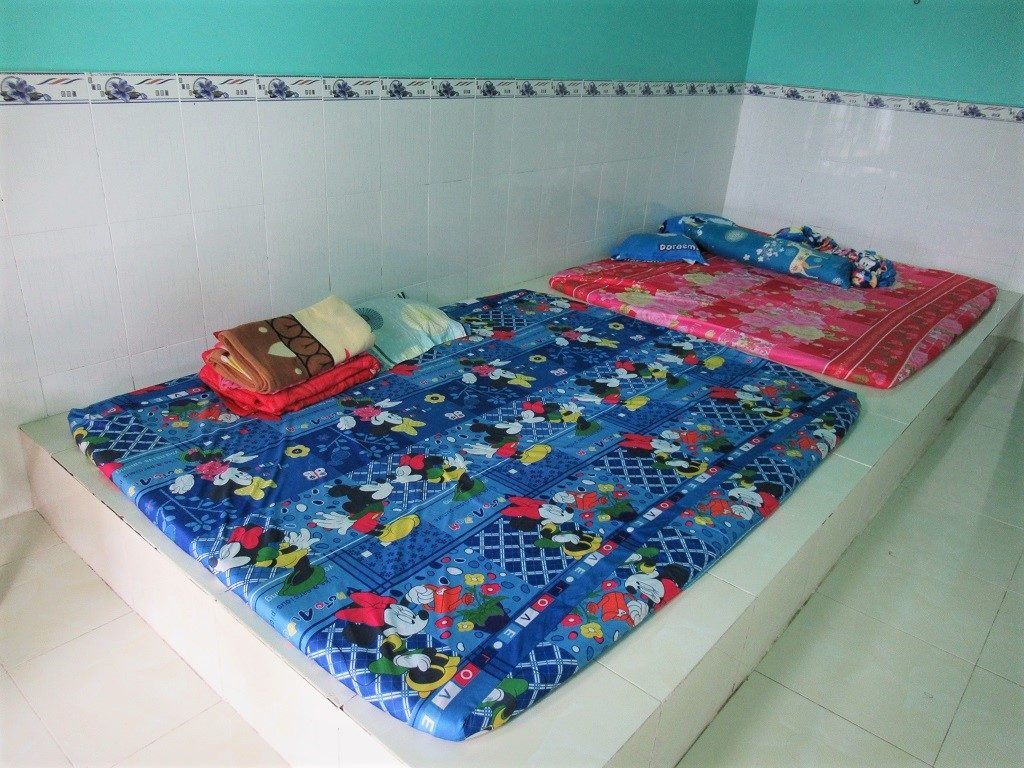
The general standard of guest houses on Pirate Island is bare & basic but comfortable (picture: Minh Nga)
• Ly Ly Guest House [MAP]; Tel: 01274 333 377 | 01274 333 288: Just up the hill directly behind the port, Ly Ly is a simple guest house with sparse, clean rooms, hard mattresses on wooden beds, and private toilet and shower. It’s in ‘town’ but within 5 minutes’ walk of Bai Bac Beach to the north, or the ferry pier to the south.
• Perfect Beach Hammocks [MAP]: In the far west of the island, this little wooden platform is raised above the sea in one of the prettiest spots on the island. Hammocks are strung up on wooden beams beneath a roof, but the sides are open to the sea breeze. Come during the day to relax, or stay overnight (but remember to bring bug spray and/or a mosquito coil).
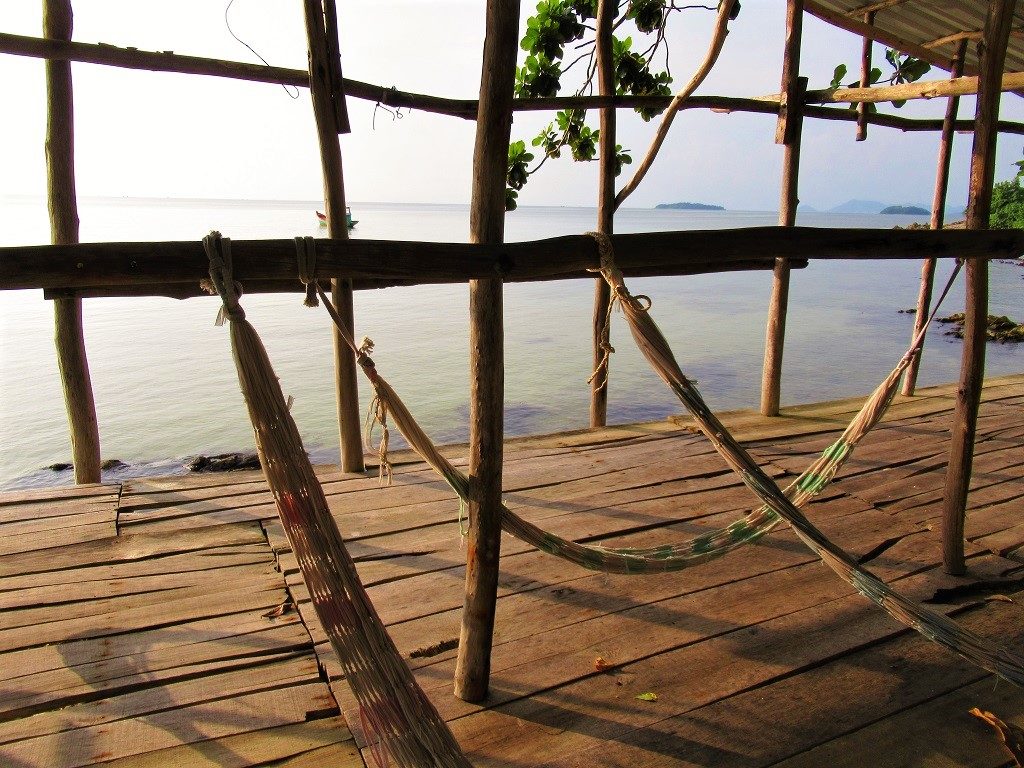
Hammock platforms can be found around Pirate Island’s coast; they can be rented for the night
• Minh Luan Guest House [MAP]; Tel: 01687 608 037 | 0773 855 893: A sprawling, scruffy place occupying a pretty promontory jutting out at the west of the island, Minh Luan has a few simple rooms with shared bathrooms, and lots of activities, such as fishing trips and seafood feasts. It’s all about the location, not the rooms. Sadly, trash is beginning to be a problem here.
• Huynh Duc Guest House [MAP]; Tel: 0949 336 447 | 0915 477 411: Up a steep lane from the coast in the north of the island, Huynh Duc has several attractive looking bungalows set on a lush hillside overlooking the sea. Inside, the bungalows are large, musty and damp, with lots of wooden furniture. Although the location is good and the buildings are substantial, prices start at 400,000vnd (even for single occupancy), making Huynh Duc by far the most expensive place to stay on Pirate Island. Access to the beach, however, is excellent and so is the restaurant on the veranda.
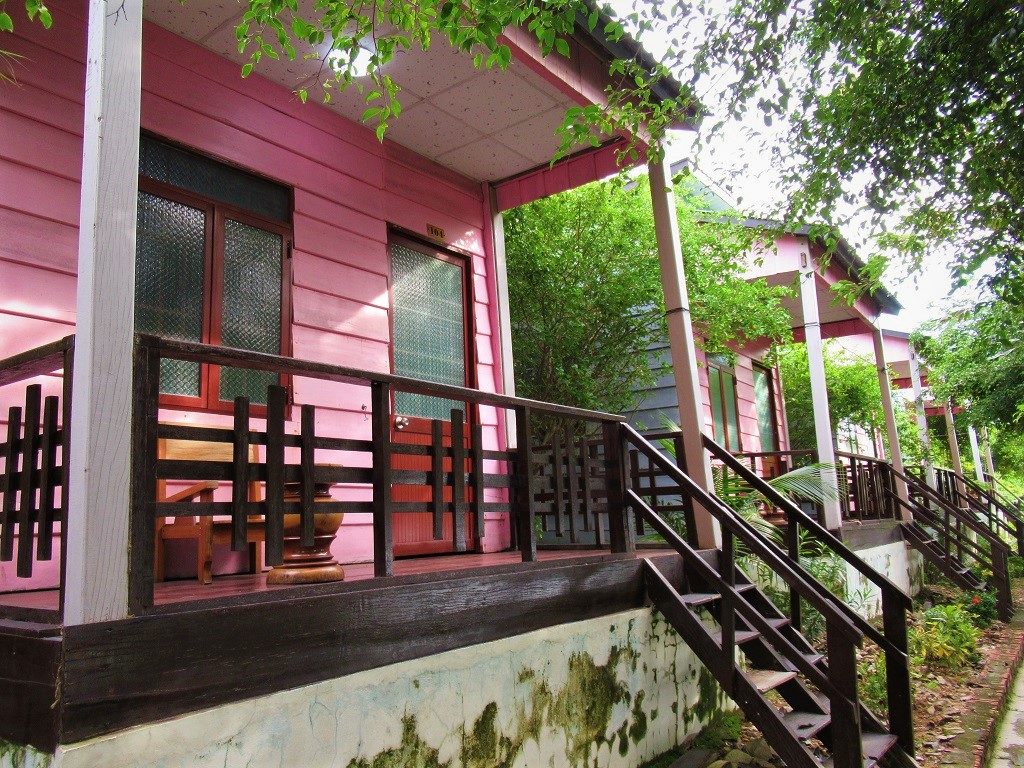
Huynh Duc Guest House has a great position on the hill above Bai Bac beach, but it’s not value for money
• Ngoc Nhanh Guest House [MAP]; Tel: 098 579 9995: On the coast road in the east of the island, Ngoc Nhanh has large, basic, clean rooms. Popular with visitors, Ngoc Nhanh is often full, so try calling in advance, especially if you’re travelling on a weekend. The main settlement is easy walking distance, but the coast around Ngoc Nhanh is rocky and not suitable for bathing.
• Huong Xua Hammocks [MAP]; Tel: 0382 006 422: On its own little islet, just off the north coast, Huong Xua is best known as a seafood restaurant, but it also rents hammocks, which are arranged in rows on a raised platform above the sea. It’s a pleasant location for a daytime nap, if not overnight. Again, trash is becoming a major concern here. Access to the sea and Bai Bac Beach is good.

Hammocks on a breezy platform at Huong Xua: perfect for the daytime, and the cheapest option for the night
• Son Hai Guest House [MAP]; Tel: 0974 010 007: Right at the centre of the long, white sands of Bai Bac Beach, in the north of the island, Son Hai is a great seafood restaurant, but also has a couple of simple rooms and hammocks available. You can’t get much closer to the sea than this.
• Beach Bungalows (under construction) [MAP]: At the time of writing (October 2019), it looked as though a few fairly substantial beach bungalows were being constructed on Bai Bac, at the western end of the beach.
• Hon Tre Vinh Island Resort [MAP]: The small island of Hon Tre Vinh is just off the west coast of Pirate Island. There’s accommodation here belonging to River Hotel in Ha Tien. Staying overnight usually requires buying into a package, which can be expensive. Contact River Hotel for details (www.riverhotel.info). River Hotel also has resort plans for the large island to the south of Pirate Island.

The range & quality of accommodation on Pirate Island is bound to expand soon, once there’s 24-hour electricity
Food & Drink:
Being only a little island in a tiny archipelago with a small population, you wouldn’t expect Hai Tac Island to have much of a dining scene. Indeed, food and drink outlets are very limited. But, this being Vietnam (one of the greatest foodie nations on Earth), there are still a handful of places to get a good feed. Seafood, obviously, is the staple of most island residents. But there are also a couple of rice and noodle eateries, and even a local street food scene:
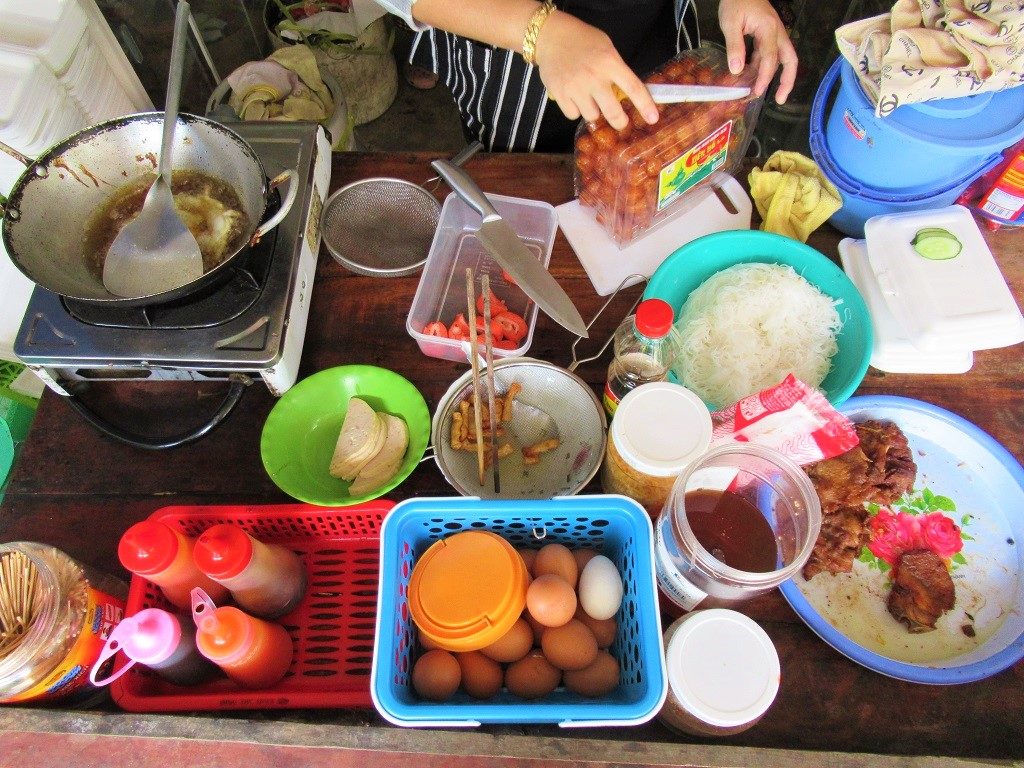
Pirate Island is a very small place with a small population, but there’s still some good food around
Eating: There are several informal seafood shacks (quán hải sản) around the island, mostly lining the coast road, in particular by the fishing marina. Locally famous are Son Hai, on Bai Bac beach, Minh Luan, on the western promontory, and Huong Xua, on the islet just to the northeast. At any of these places you’ll find fresh shellfish, fish, crustaceans and cold beer, as well as obliging hosts who will help decipher the day’s menu/catch. Also, your accommodation will either be able to recommend a place or cook some seafood up themselves.
Around the port is where most of the island’s food stalls are located. For breakfast and lunch (7am-9am and 11am-12.30pm) a couple of cơm-phở (rice and noodle) shacks open next to the crossroads, serving rice, pork and egg (cơm sườn trứng), and squid noodle soup (mì mực). Both are fine to fill you up and inexpensive (30,000vnd). A couple of stores line the inland road between the port and Bai Bac beach, particularly opposite the primary school, where shops sell sweets, cakes, crisps and filled baguettes to the kids at break times (this is a good snack option during the day). In the evenings, a little street food scene pops up just behind the port. Here you’ll find grilled fish, barbecued chicken and other such delights. It’s a great atmosphere, with many local families meeting and eating together, and their children playing in the empty street. Because the island and its population are so small and friendly, you might also find you get invited to partake in a meal at someone’s home, or join in the picnic of visitors from the mainland.

Seafood is the staple of the island: this is squid noodle soup for breakfast near the port
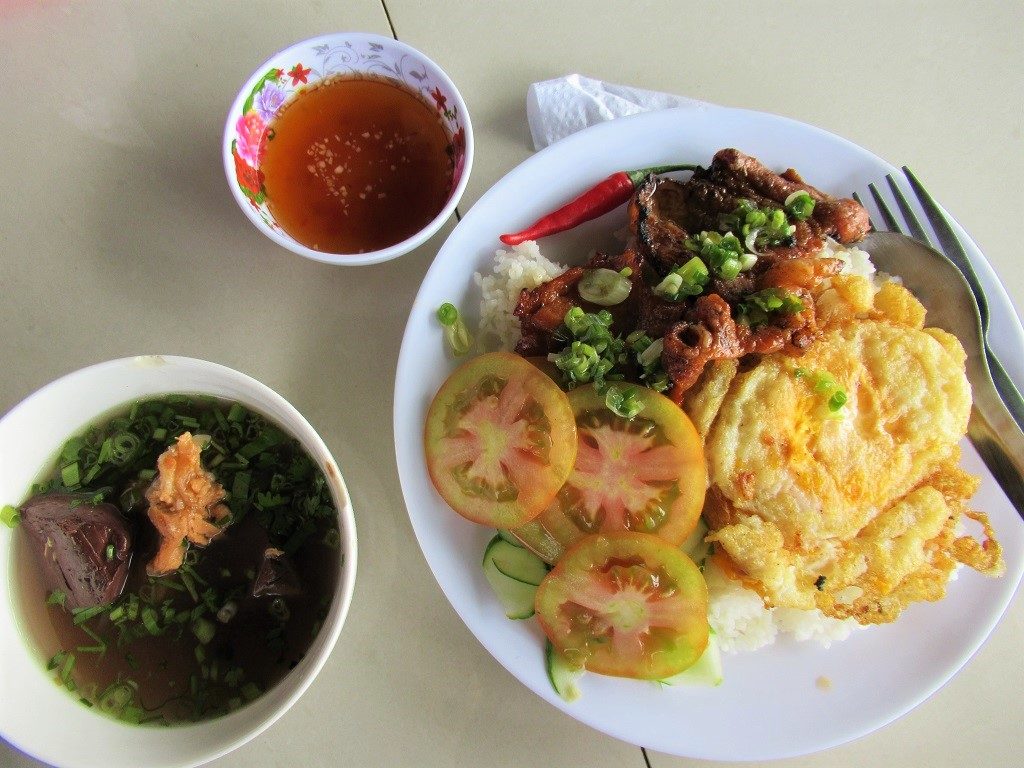
A typical rice lunch of pork, eggs & soup at one of several food shacks on Pirate Island
[Back]
Drinking: There’s a very limited range of drinking options on Pirate Island. The shops and eateries mentioned above all sell the usual sodas, soft drinks, and local beer. There are a couple of pleasant seaside cafes around, including one opposite the ferry pier, where you can get Vietnamese coffee. The night street stalls serve trà tắc (a popular refreshing drink of iced tea and calamansi juice) and some of the kiosks around the island sell trà sữa, the extremely trendy, flavoured, sweet, milk tea that’s taken the whole of East Asia by storm. But you won’t find anything like an espresso or a cocktail. As with any self-respecting fishing community in Vietnam, there are plenty of beer-swilling get-togethers throughout the day and night. During these informal gatherings on people’s front porches, the locals on Hai Tac Island become even more friendly and open: prepare yourself for a long and jovial evening of alcohol and banter.
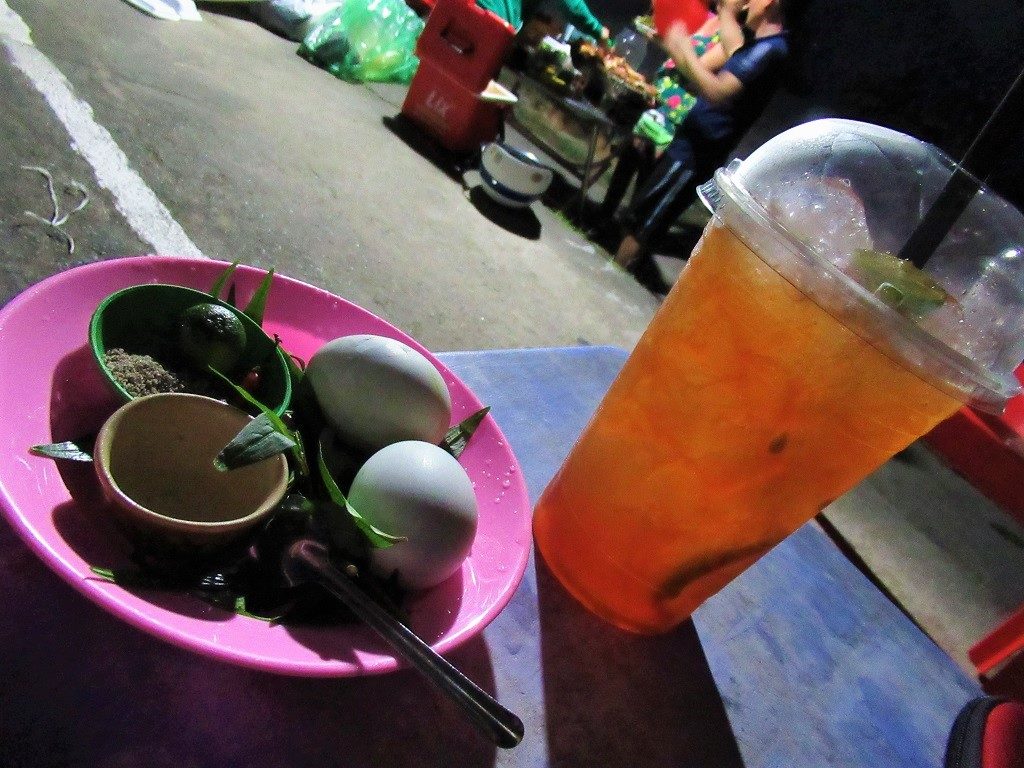
Pirate Island has a few simple cafes & at night trà tắc (iced calamansi tea) is available near the port
Getting There & Around:
*Please support Vietnam Coracle: If you use the links & search boxes below to book your transportation through Baolau.com, I make a small commission. All my earnings go straight back into this website. Thank you.
Pirate Island can only be reached be sea from Ha Tien, in the southwestern-most corner of the Mekong Delta. There are several boats in both directions every day. Journey time is 40-90 minutes depending on the vessel and sea conditions. Most boats can also accommodate motorbikes and bicycles. Ticket prices are very reasonable and booking is fairly straightforward. Ha Tien is well connected to other hubs in the Mekong Delta region and there are plenty of comfortable sleeper buses serving Saigon (Ho Chi Minh City). Once on Pirate Island, you can easily get around on foot or on two wheels. Boats can be hired to visit the outlying islands. See below for details:
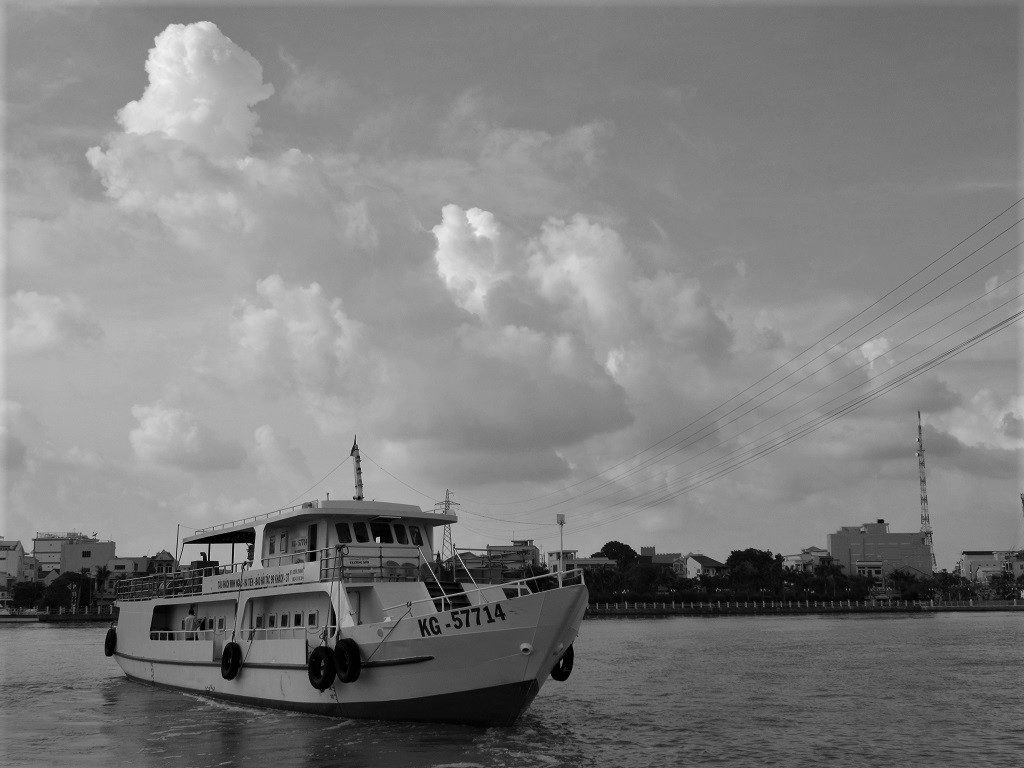
Pirate Island can only be reached by boat from Ha Tien, in the southwestern corner of the Mekong Delta
By Air: The nearest airport to Ha Tien is 90km to the east, at Rach Gia. Vietnam Airlines operates one daily flight in each direction between Saigon and Rach Gia. Flights are in the morning ($35/$70 one-way/return). From Rach Gia there are regular buses throughout the day to Ha Tien (2 hours):
- Search Saigon↔Rach Gia flights on Baolau.com HERE
By Bus & Motorbike: Ha Tien’s bus station has relocated to the south side of the river, not far from the boat piers. The new bus station is relatively well-organized and user-friendly. There are good bus connections from Ha Tien to most major cities in the Mekong Delta and to Saigon (Ho Chi Minh City). Regular buses ply all major regional routes, including Rach Gia, Chau Doc, Long Xuyen, Can Tho, Ben Tre and Ca Mau. I assume that most travellers will be coming from/going to Saigon. This route is served almost hourly throughout the day and night (with a hiatus during lunchtime) by good quality sleeper buses. In particular, Kumho VIP buses and Futa buslines are excellent (the former can also carry your motorbike onboard for 400,000vnd). Passenger ticket prices are reasonable (between 120,000-190,000vnd) and levels of comfort are pretty good these days, with nearly flat relcining bed-chairs. Journey time is 8 hours depending on traffic, but the duration is reduced each time a new Mekong infrastructure project is completed, such as was the case in 2019 with the opening of the Vam Cong bridge, negating the time-consuming and over-used ferry crossing. [You can search Ha Tien bus schedules in the search box below or on Baolau.com HERE]
Search & Book: Type your travel dates below & click ‘Search’ to find current ticket prices & availability for buses between Ho Chi Minh City & Ha Tien on Baolau.com:

Ha Tien has good bus connections to all major Mekong Delta cities & Saigon (Ho Chi Minh City)
[Back]
GETTING TO PIRATE ISLAND:
The only way to get to the Pirate Islands is by boat from Ha Tien. There are generally at least two sailings each day in both directions. The crossing usually takes under an hour, and motorbikes and bicycles can be loaded onto the boats. As a foreign traveller, you do not need a permit to visit the Pirate Islands any longer, but you will need to show your passport to book your boat ticket. See below for details:
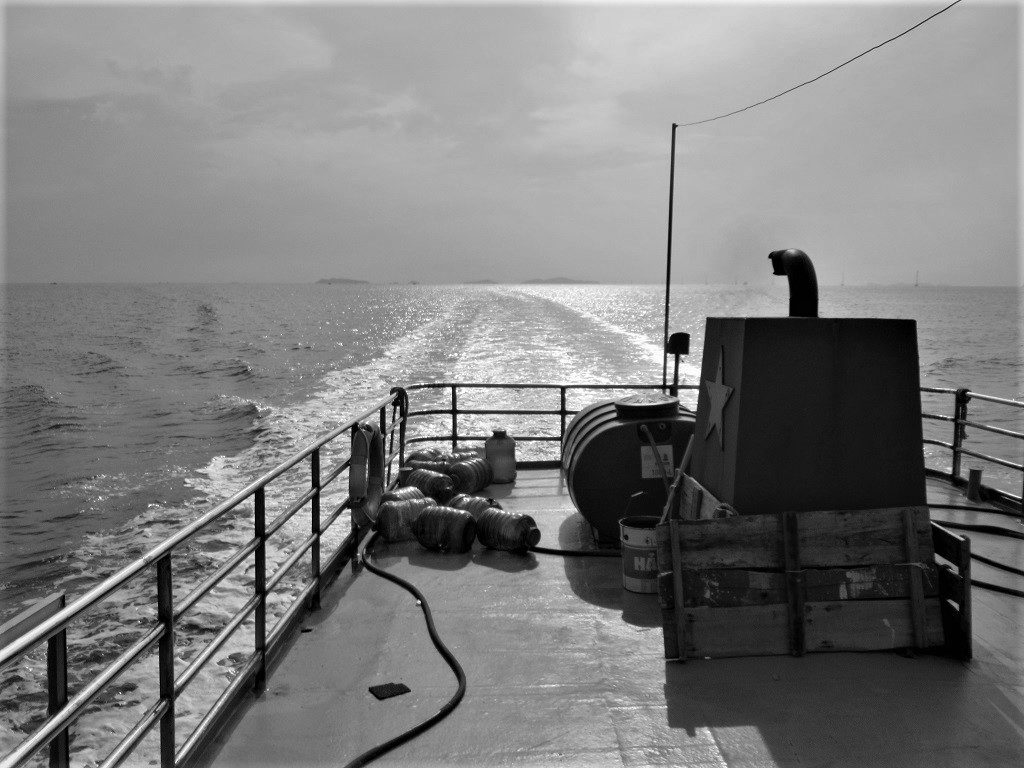
Several ferries run daily between Ha Tien & Pirate Island: the crossing takes about an hour
[*Note: all ferries to Pirate Island are advertised to Tiên Hải or Đảo Hải Tặc]
Although several ferry companies operate boats between Ha Tien and Pirate Island, only Minh Nga seems to reliably run each day. Other companies include Huong Xua (a fast ferry) and Pha An Hai (a small vehicle ferry). However, neither of these were actually operating at the time of writing. My guess is that they run on weekends, public holidays, and during high season months (November to April) only. Minh Nga ferries leave twice a day in both directions: one in the morning, one in the afternoon. However, on weekends and whenever demand is high, this schedule will double. The crossing takes approximately 1 hour. Ticket prices are 50,000vnd per passenger, and 50,000vnd per motorbike (plus a 30,000vnd handling fee at both ports). Sailings to Pirate Island are bound to increase from the end of 2019, once the islands are connected to the national grid and visitor numbers are expected to rise. The boat schedule and ticket prices below are subject to change and depend on weather conditions. (Note that the schedules published on signboards at the ports are almost always inaccurate, but are a good indication of sailing times):
HA TIEN → PIRATE ISLAND (Tiên Hải/Đảo Hải Tặc)
Departures: 8.15am (Minh Nga), 1.00pm (Minh Nga) daily*
Duration: 1 hour
Passenger Ticket: 50,000vnđ
Motorbike Ticket: 50,000vnd + 30,000vnd handling fee at both ports = 110,000vnd total
*At least two sailings daily operated by Minh Nga; extra sailings in high season (November-April) & weekends, plus other boat operators
PIRATE ISLAND → HA TIEN
Departures: 8.30am (Minh Nga), 2.30pm (Minh Nga) daily*
Duration: 1 hour
Passenger Ticket: 50,000vnđ
Motorbike Ticket: 50,000vnd + 30,000vnd handling fee at both ports = 110,000vnd total
*At least two sailings daily operated by Minh Nga; extra sailings in high season (November-April) & weekends, plus other boat operators

Loading up: boats between Ha Tien & Pirate Island leave at least twice daily in both directions
[Back]
Ports & Ticket Offices:
[*Note: all ferries to Pirate Island are advertised to Tiên Hải or Đảo Hải Tặc]
Ha Tien port is located across the river from town, on the south bank of the Giang Thanh River. Tickets can be booked at any number of the dozens of kiosks that cluster around the port. Look for signs advertising boats to Tiên Hải or Đảo Hải Tặc (both are alternative names for Pirate Island). However, it’s perhaps easiest to go to the main (new) terminal building, and go to the ticket office on the far left (as you’re looking at the building from the outside) and ask for tàu đi Tiên Hải/Đảo Hải Tặc (boats to Pirate Island). Unless it’s a weekend or public holiday, tickets should be able to be purchased on the day of travel, just 30-45 minutes prior to departure. However, it’s a much better idea to buy your tickets a few hours (or even a day, if possible) in advance. If you don’t want to deal with Ha Tien’s busy port, you can probably buy tickets through your hotel in town: just ask reception to arrange it. You must have your passport to book tickets. (Note that the schedules published on signboards at the ports are almost always inaccurate, but are a good indication of sailing times.)
Tickets for motorbikes or bicycles are purchased at the pier, before boarding the boat: make sure you get there 30 minutes before departure. When I did it, I wasn’t asked for my motorbike green/blue card or driving license.
In Ha Tien, boats to Pirate Island tend to leave from the older of the two port buildings, known as Pier No.1: this is the one on your left as you’re facing the river.
On Hai Tac Island, tickets are purchased at the café beside the Bien Phong (border control) office, directly opposite the pier where the boats dock, on the south coast.
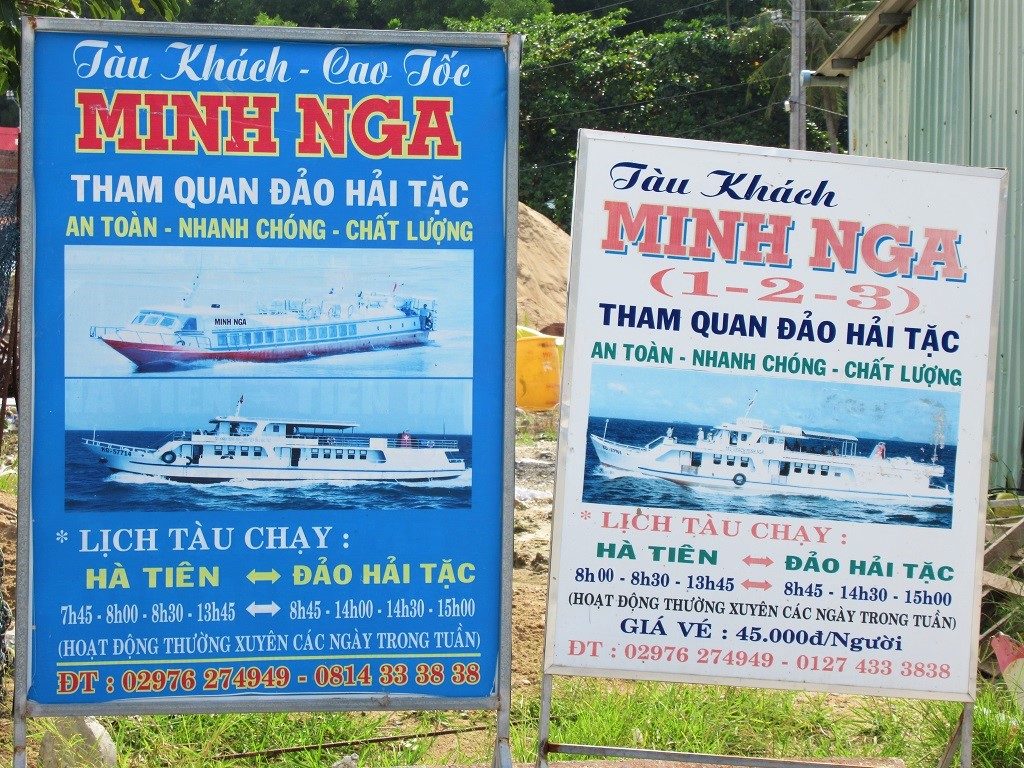
Although several companies run ferries to Pirate Island, Minh Nga seems to be the most reliable
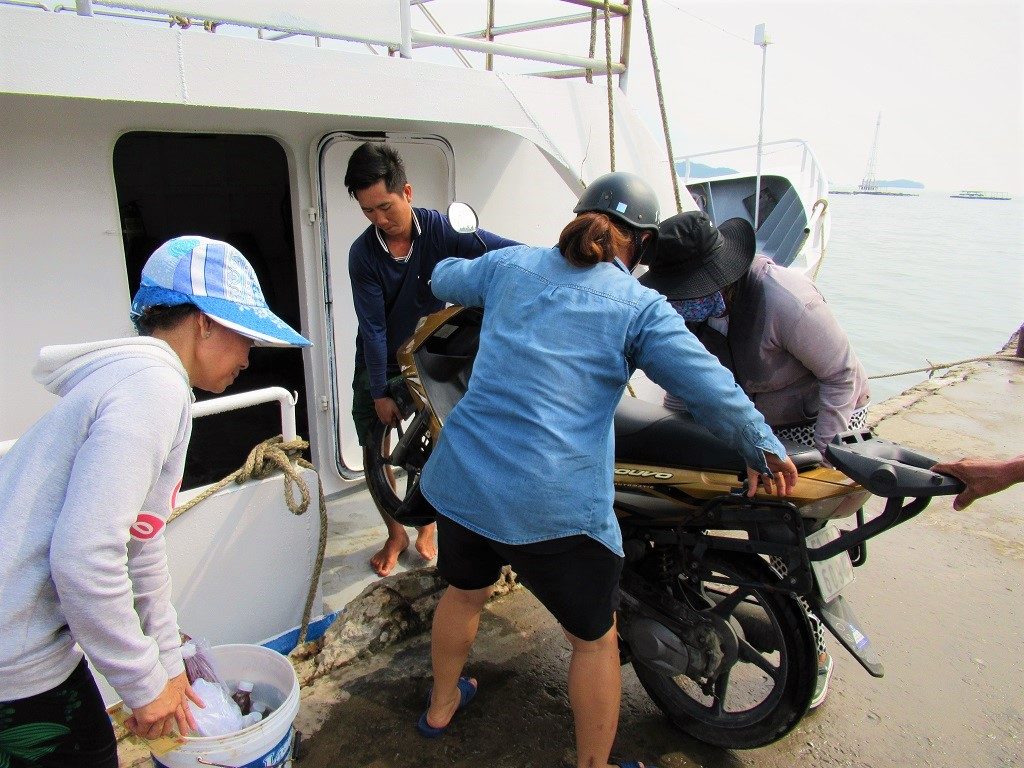
Motorbikes can be carried on most vessels on the crossing between Ha Tien & Pirate Island
[Back]
The Boats & the Voyage:
Although several different companies operate boats to Pirate Island, Minh Nga appears to be the most frequent and the only one that reliably sails each day. Minh Nga operates three very different vessels: a handsome yacht-like ship with a neat Vietnamese-star funnel at the back and plenty of outside deck space; a long and narrow fast boat with coach-style seating; and an old wooden hulk that chugs through he waves, its passengers lying on bare wood-plank floorboards inside, or sat on plastic chairs on the deck at the back. Journey time is anywhere between 30 minutes to over an hour, depending on the vessel and sailing conditions. All boats accept motorbikes. The voyage is very pleasant. Leaving Ha Tien involves sailing under the To Chau Bridge and out of the Giang Thanh estuary. The green hills of Mui Nai Cape provide a scenic backdrop as Ha Tien recedes into the distance. The water colour changes from brown to blue as the river is diluted by the sea. Pirate Islands get steadily closer: going from hazy silhouettes on the horizon to forested nuggets dotting the glass-like waters of the Gulf of Thailand. The boat docks at the ferry pier on the south coast of Pirate Island, surrounded by fishing boats.
NOTE: It’s worth pointing out that there is now an alarming amount of plastic floating in the ocean for the entire length of the voyage. It wasn’t always like this, and one wonders how much more it will take before we all make significant changes to what we consume and how we carry, store and discard the things we use.
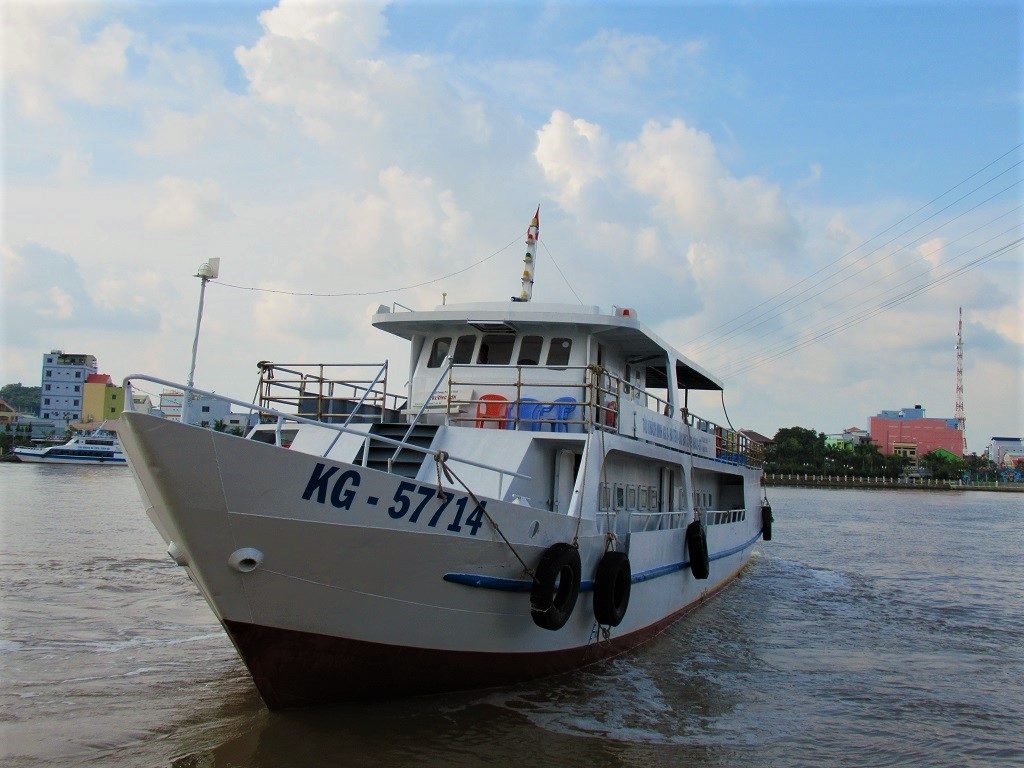
Minh Nga operates a couple of different vessels to Pirate Island: this is the more shapely of them
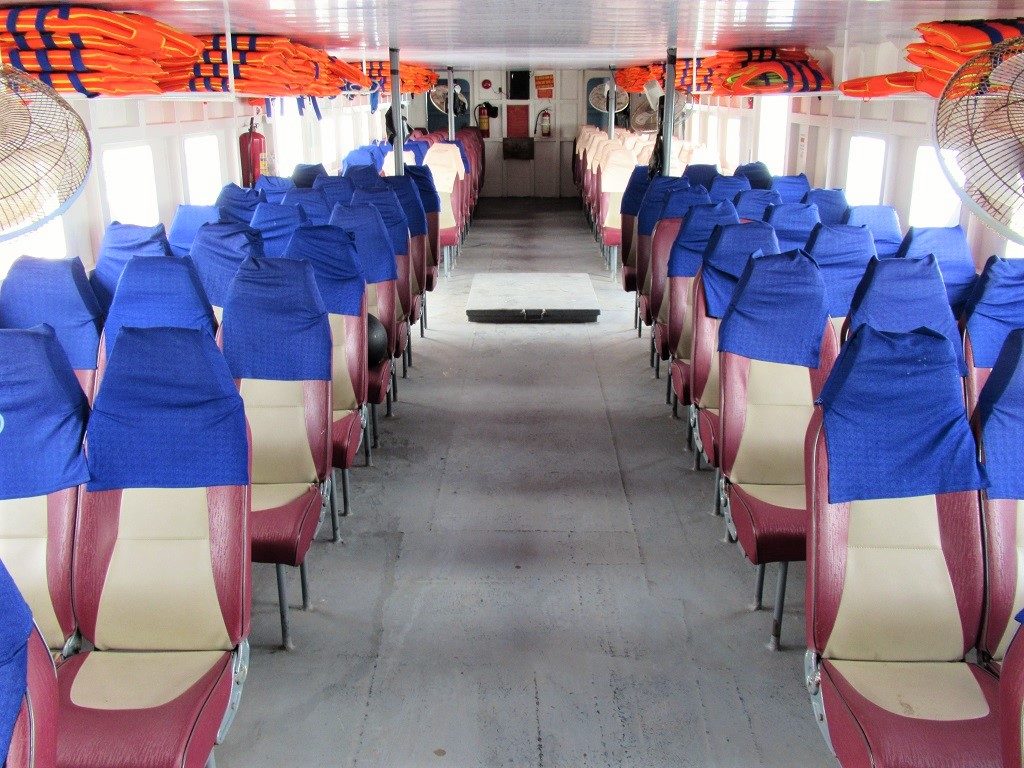
Inside, seating is on soft coach-style chairs, but there’s also lots of good open-deck space

The second Minh Nga vessel is this old wooden hulk which chugs along through the waves
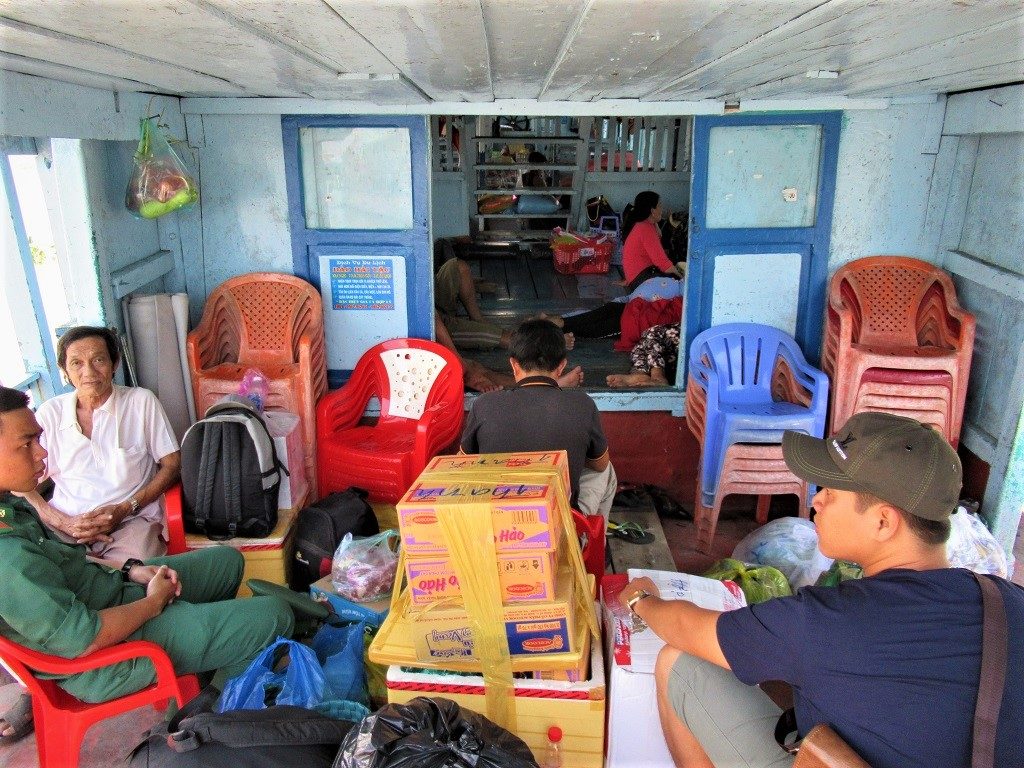
Inside the wooden vessel, seating is on plastic chairs, or lying flat on the wood-plank deck
[Back]
GETTING AROUND PIRATE ISLAND:
Pirate Island may be the largest island in the archipelago, but it’s still very small indeed. Getting around the main island is easy, whether on foot, on two wheels, or in an electric buggy. Getting around the archipelago can be done by hired boat:

Getting around Pirate Island is easy: choose from a motorbike, bicycle, boat or on foot
By Motorbike, Bicycle & on Foot: Pirate Island has a modest road network, including a paved lane following the entire coastline, and two short and steep inland roads connecting the coasts. You can, of course, bring your own two wheels with you on the boat from the mainland (see Getting to Pirate Island for details), but motorbikes and bicycles can also by rented from many (but certainly not all) of the accommodations on the island. Motor-powered or pedal-powered, the island is easily navigable and pleasant to explore, as the roads are very pretty and traffic minimal. The entire circuit of the island is less than 5km, which means walking is a great option, too. Everywhere on the island is within walking distance and, with the exception of the steep inland roads, very gentle exercise. An electric buggy can be hired for a tour of the island’s roads, beaches, and sights. It tends to run on weekends and holidays, but if you ask at Minh Nga or Phuong Thao I’m sure they’ll be able to arrange it for you. However, the buggy really isn’t necessary: it’s far nicer to amble around the island on foot or two wheels, stopping for swims, snacks, naps in hammocks, photos and chats with local people.
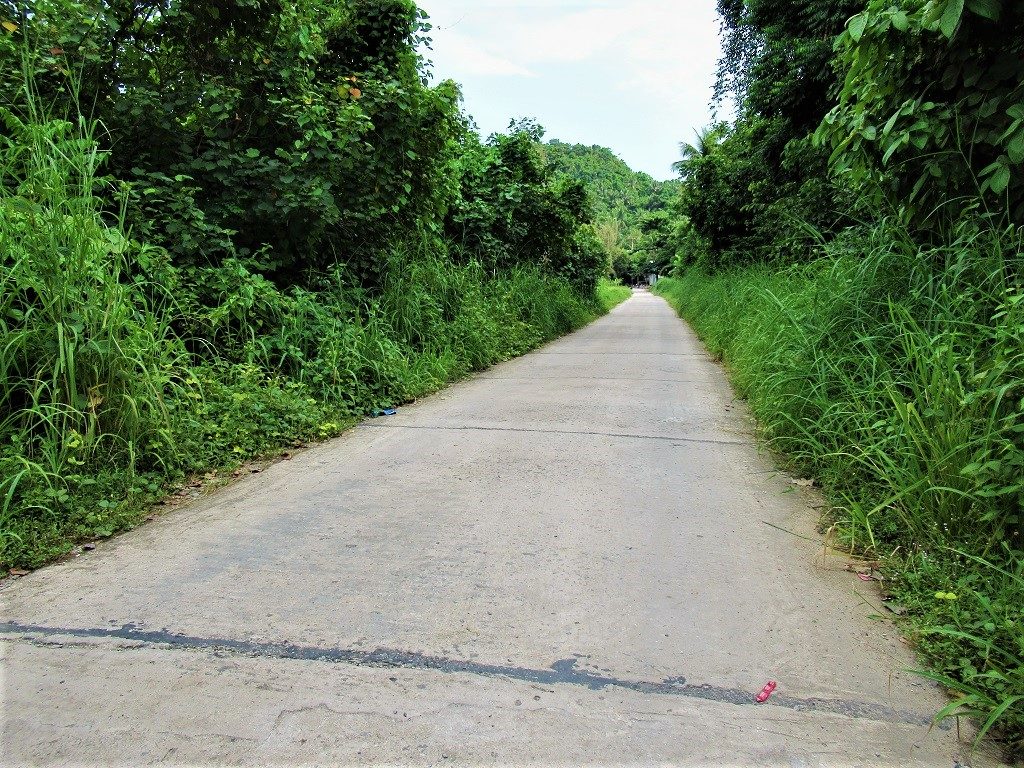
Pirate Island’s deserted & scenic roads are perfect for walking or riding: distances are short
[Back]
By Boat: Of the 16 islands in the archipelago, a few are large enough to be permanently inhabited, and a couple have very nice, secluded beaches and bays that can only be reached by boat. From Pirate Island, boats can be hired to any of the islands. You can ask and arrange a boat through your accommodation (try Phuong Thao, Minh Nga and Minh Luan) or you could even try your luck negotiating down at the local fishing marina (but this is best if you speak some Vietnamese). It’s difficult to judge prices, but you can expect to pay anywhere between 100,000-700,000vnd depending on how far and how long you want to go. I’m sure that the boat trips system will become more formalized soon, because, once the islands are hooked up to the national electricity gird, the hope is that tourism will rapidly increase.
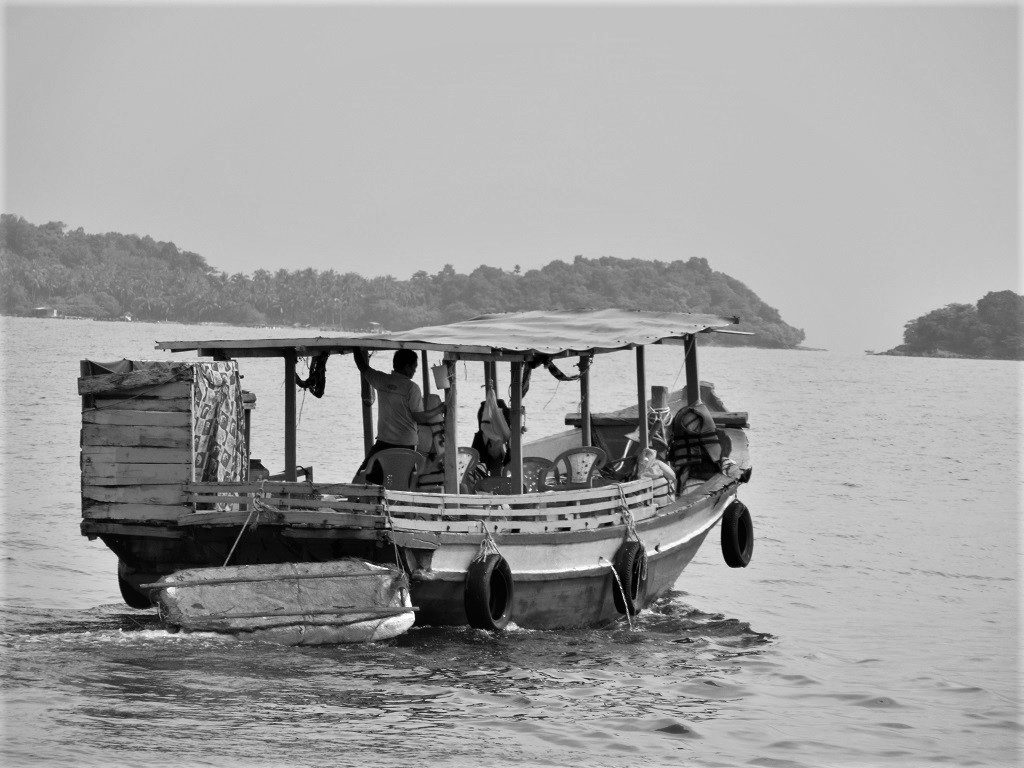
It’s fairly easy to hire a boat to visit the other islands in the Pirate Archipelago
Weather:
Like other regions of southern Vietnam, the dry season months (roughly November-May) are the best time to visit the Pirate Islands. During these months, conditions are generally bright, sunny, warm and dry, and the sea is wonderfully calm. The rainy season months (roughly June-October) can see quite rough seas and plenty of tropical downpours. Indeed, it can be very dramatic on the islands during rainy season: watching the cloud cathedrals bubble up over the Cambodian mountains to the north and east, lightning flaring in the evening sky before the rains hit, drumming on the corrugated iron rooftops of the fishermen’s shacks. However, the shoulder months (October and May) are probably the very best times to visit, because the weather is still decent and visitors are few. Note that the heat and humidity on the Pirate Islands can be intense at anytime of year.
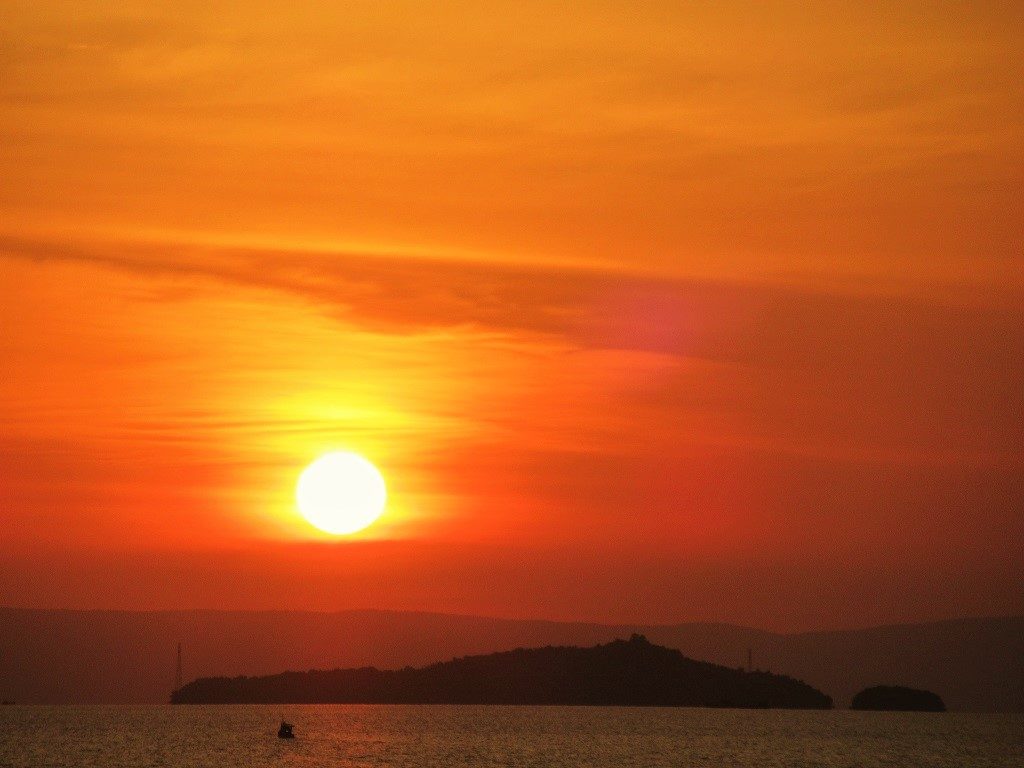
The sun sets over the Pirate Islands: weather is best from November to April
Disclosure: I never receive payment for anything I write: my content is always free and independent. I’ve written this guide because I want to: I like this island and I want my readers to know about it. For more details, see my Disclosure & Disclaimer statements here
[Back Top]

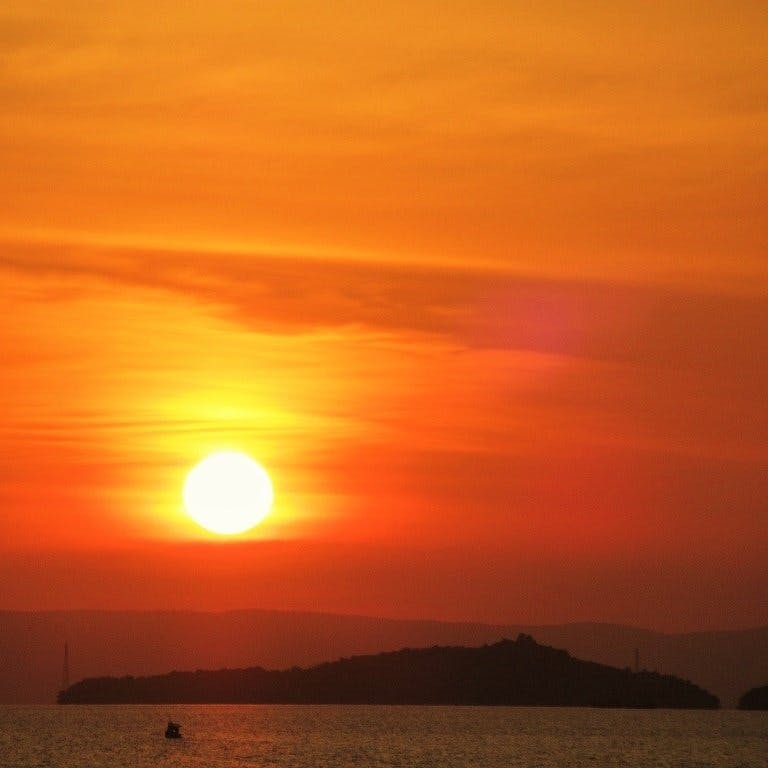
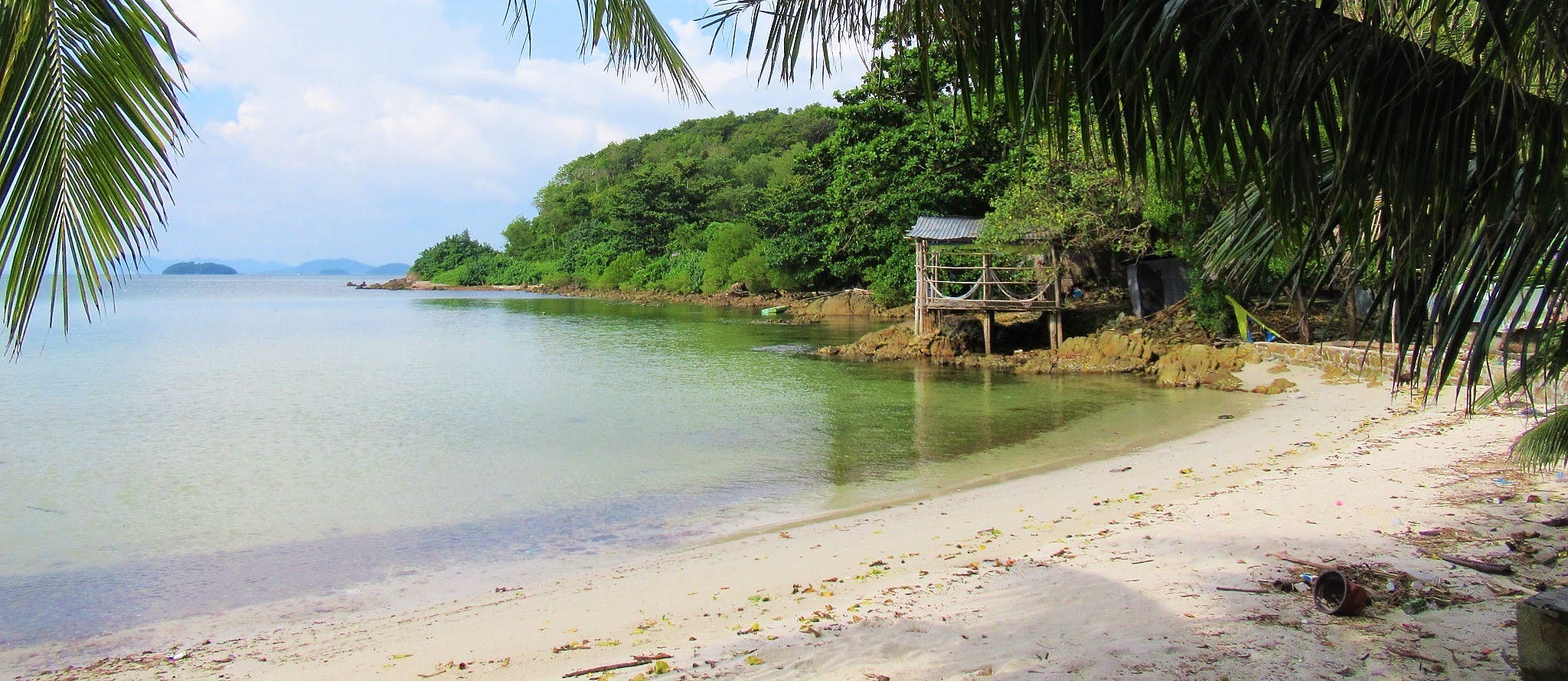
Just a quick update as of Jan/13… We (couple) were refused to rent hammocks only on the island and “forced” to pay for a room in every place we checked, which are perfect beach hammocks, Minh Luan, Minh nga and phuong thao. Anyway we were quoted 200k for the room which is a good deal and decided to overnight at minh nga (discounted at 150k)… Unfortunately the room was full of mosquitoes, not easy manageable without a self standing net.
The northern side appeared to be a bit run down accommodationwise…
Electricity is now running 24h.
Trash is everywhere unfortunately, the north coast seemed to be less affected.
People was nice and friendly everywhere and nobody tried to overcharge us for food or return boat.
Thanks for all the infos shared here!
Hi Fabio,
Thanks for the updates and sharing your experience of the Pirate Islands.
I’m sorry to hear about the hammocks – that could be a new rule, or it could be just during the high season around Tet, or maybe even for ‘security’ reasons.
It’s a great shame about the trash – a major problem everywhere along Vietnam’s coast now.
Thanks,
Tom
Hi Tom and thanks for yet another useful guide and wanted to contribute our own recent experience last week on Hai Tac Island (albeit being a bit of a downer).
Prices need to be extremely and explicitly communicated with vendors regarding food and drink. Most guesthouses can cook the seafood you buy fresh for a charge of between 50k-80k plus whatever one pays for the seafood itself at the many roadside makeshift stalls. If you want squid, get it fresh before 10am otherwise you’ll buy frozen stuff.
After living/traveling by motorbike here for 3+ years and speaking Vietnamese at an intermediate level, I found myself being scammed in Hai Tac in three days more times than I would like to admit!
As we wanted the rustic and relaxed beaches, the first thing my brother and I did after arriving was head towards the western part of the island and hung in the hammocks for a coffee which was great!
Unfortunately, what wasn’t so great was the scary and jittery persona of Luan the owner of Minh Luan Guesthouse. I would highly recommend against anyone staying or using any of his services let alone talk to him. He seemed really jittery and angry and startled my brother and I with his demeanor and intimidation. I think he might have been under the influence of something like meth.
My brother and I ended up putting up a tent and hammock (with bugnet!) nearby on the platform in your photo. That was a great tip, Tom!
Would definitely recommend avoiding the weekends like you mentioned since Saturday seemed like Karaoke auditions! 🙂
Would also add an update to the Minh Nga afternoon boat now being 100k VND back to Ha Tien but the 8am return remains 50k.
A final note regarding the nature…Lots more plastic in the water/beaches and lots of dead coral as we snorkeled. Would say it seems like a deja vu of a Phu Quoc on the rise yet to be fully developed and agree in your previous posts that the inevitable influx of even more of us tourists both foreign and national will only hamper any help.
Hi Kyle,
Thanks for sharing your experience of the island.
Sorry to hear about the overcharging. I don’t recall it being a problem for me when I was there, or if it was then the amount was so small as not to give it much thought. It could also be that everyone on the island has been told tourists will start to arrive in numbers now, so perhaps people are ‘making the most of it’.
That’s very odd about the difference of price for return boat fare.
I met Luan, but he was fine when I was there – a bit of a lad, but nothing offensive.
Sadly, the Gulf of Thailand is becoming a pond of plastic waste – it gets visibly worse with each year.
Tom